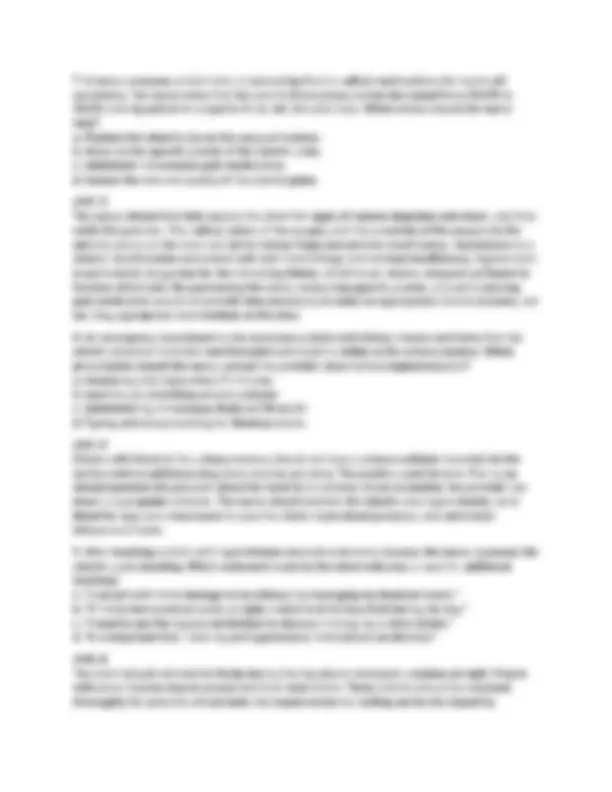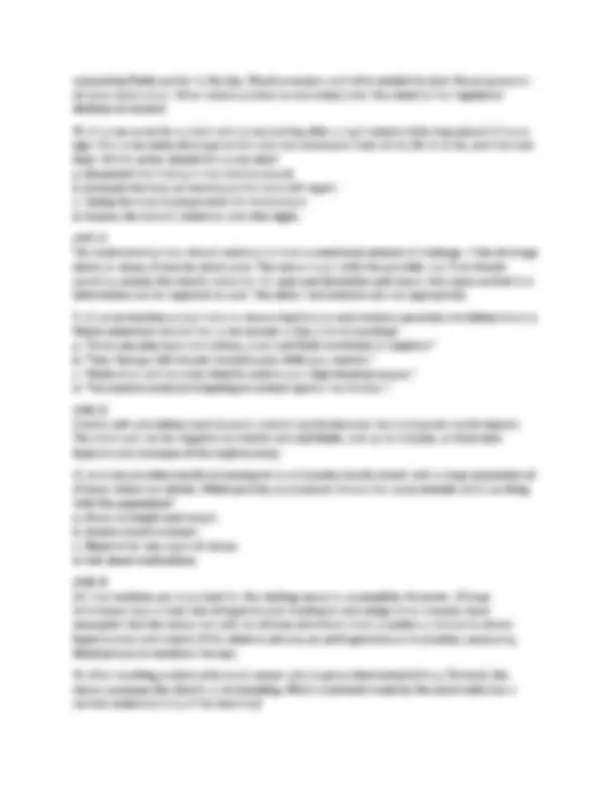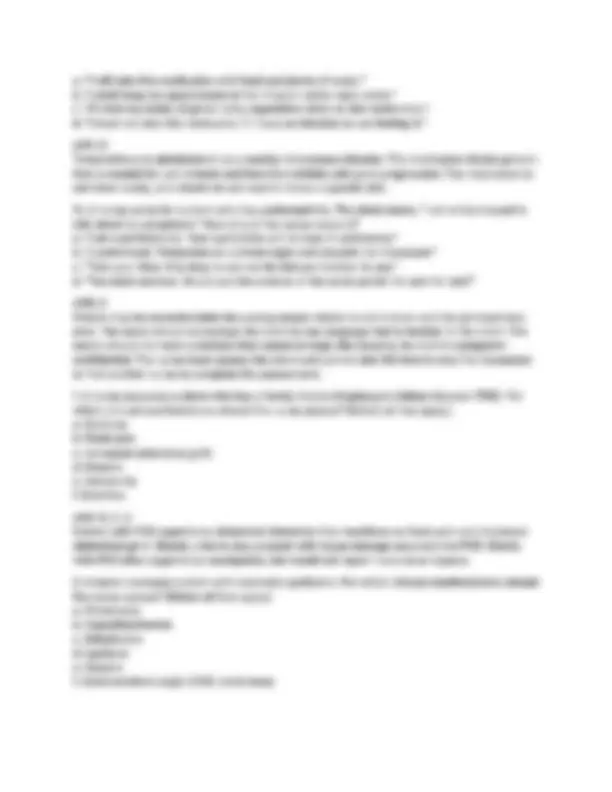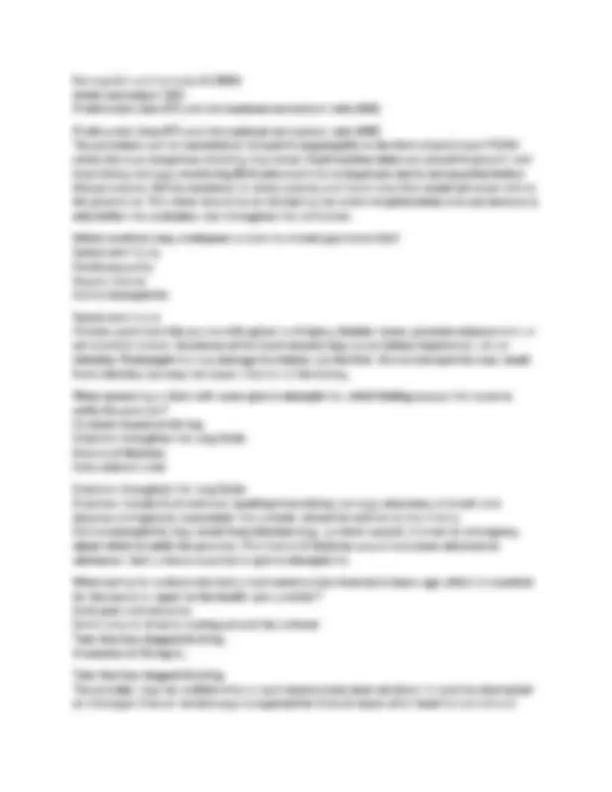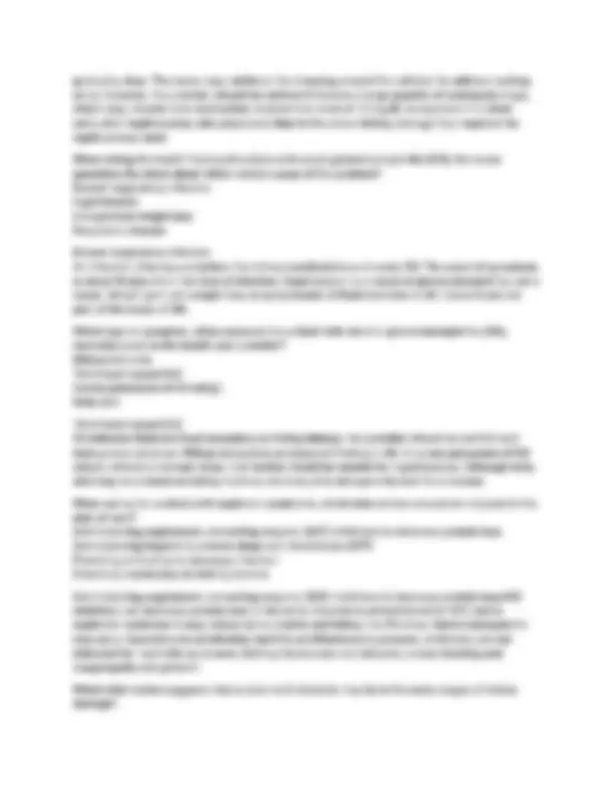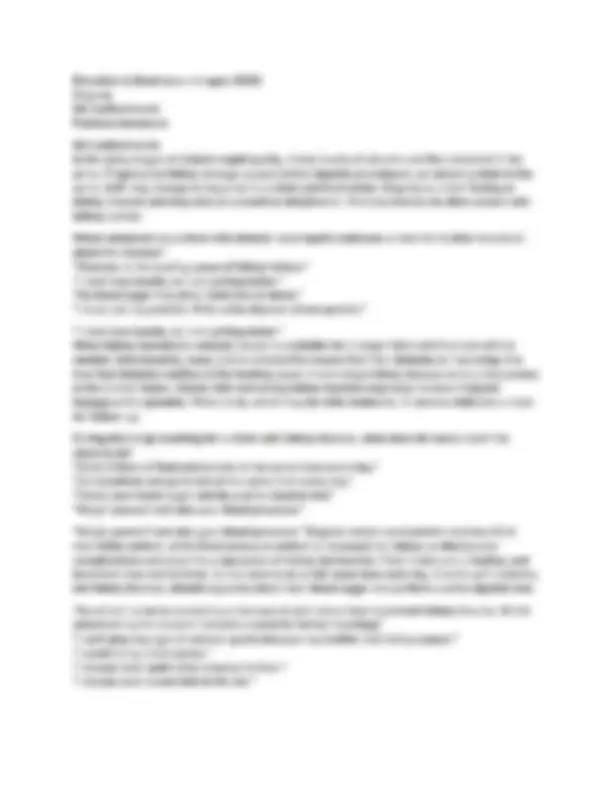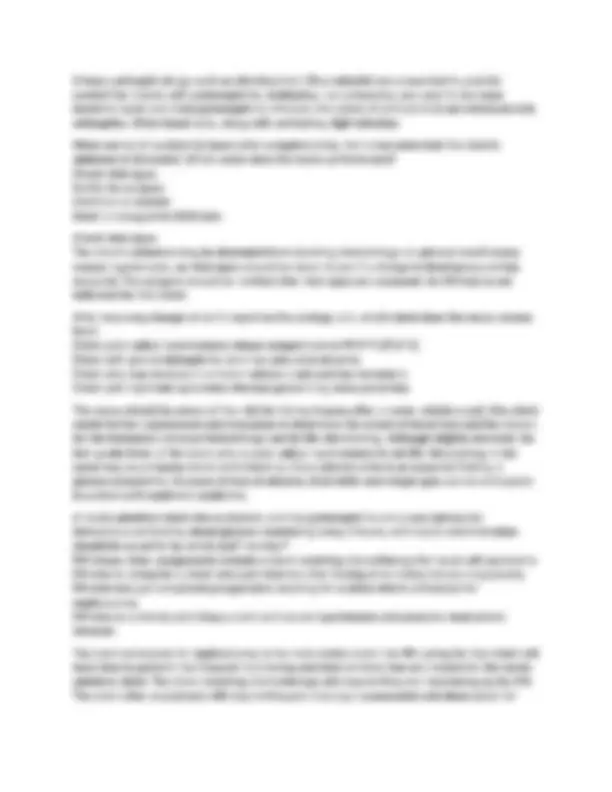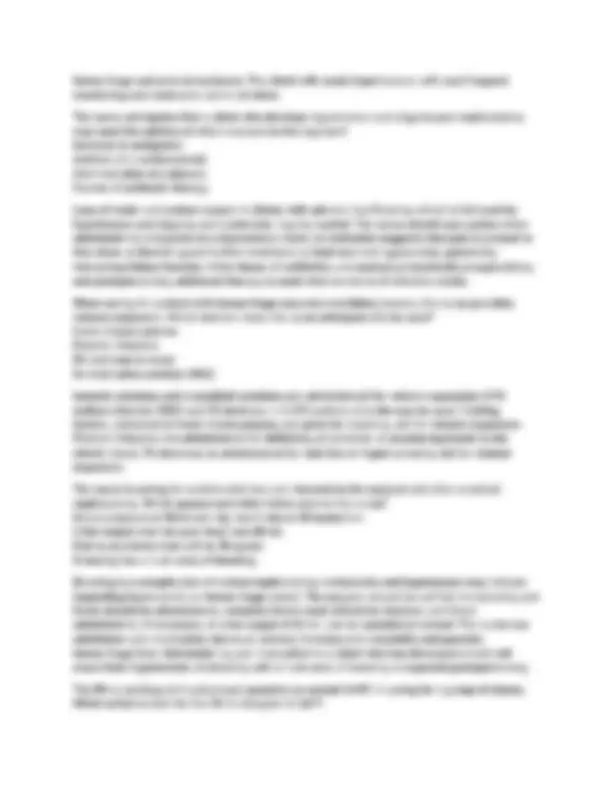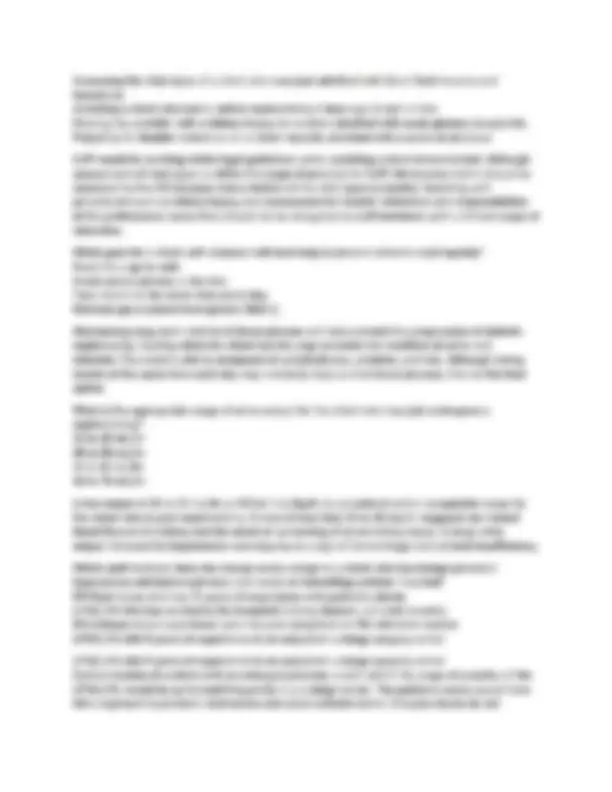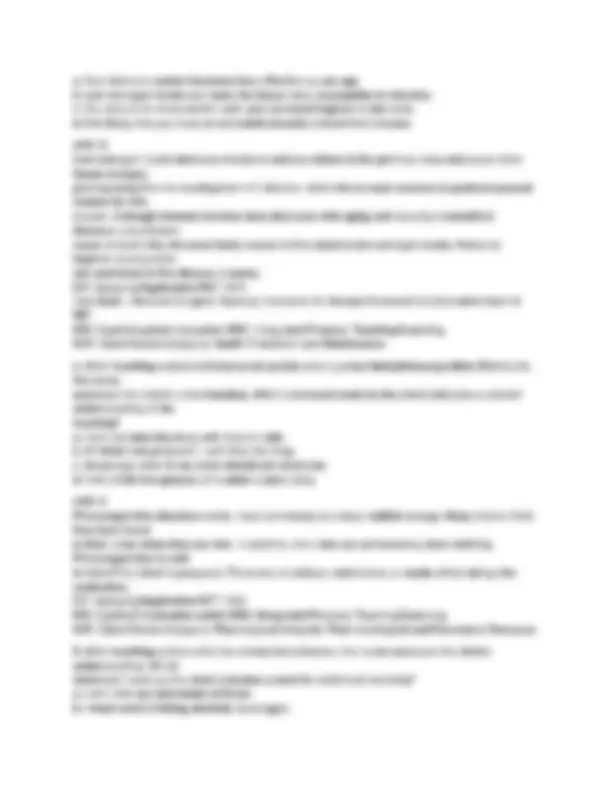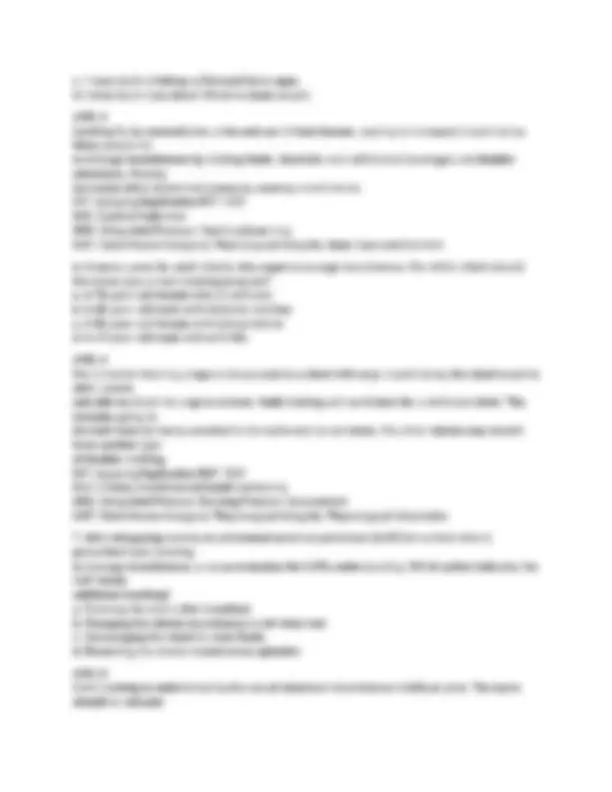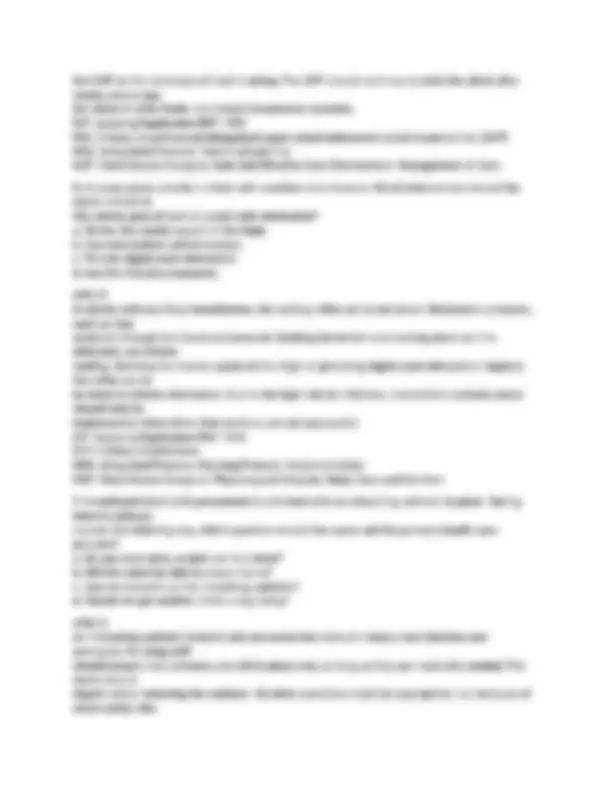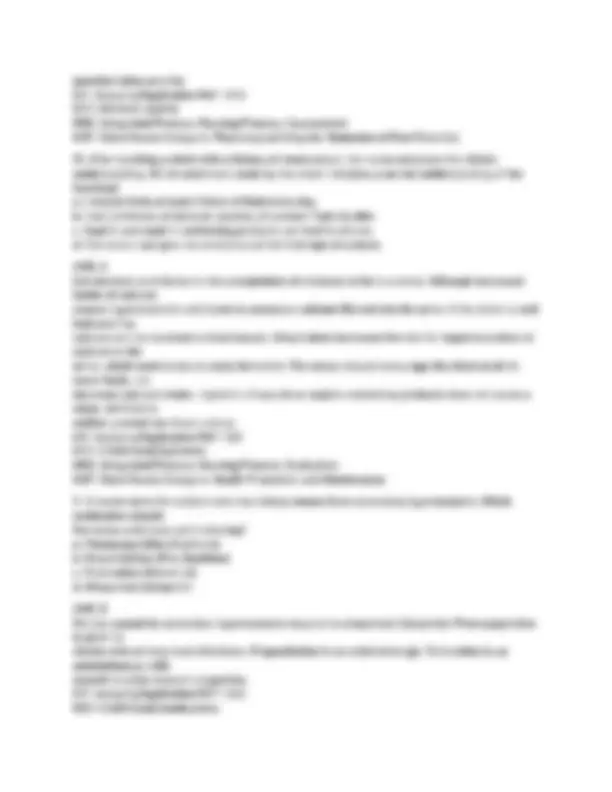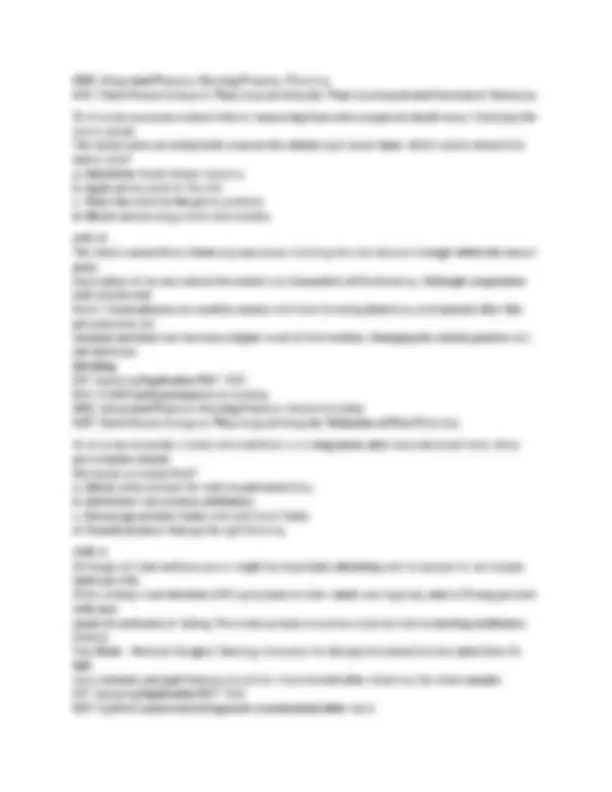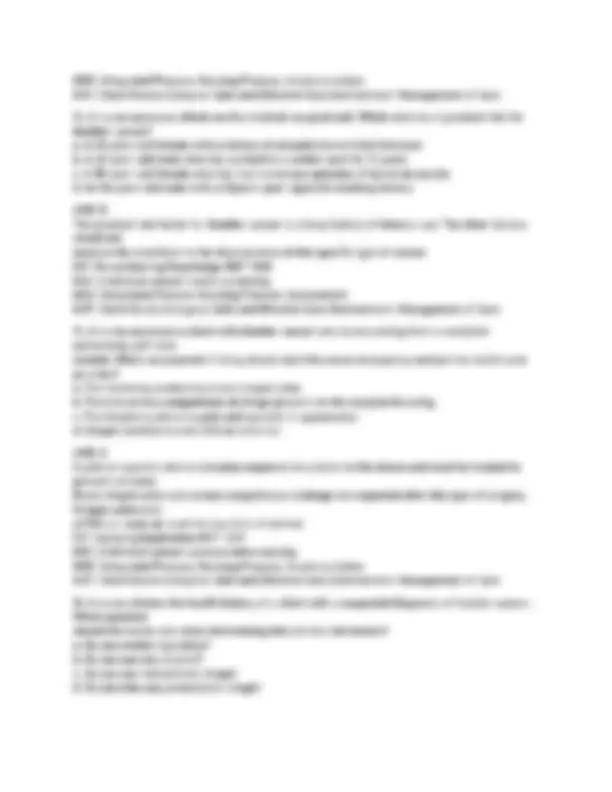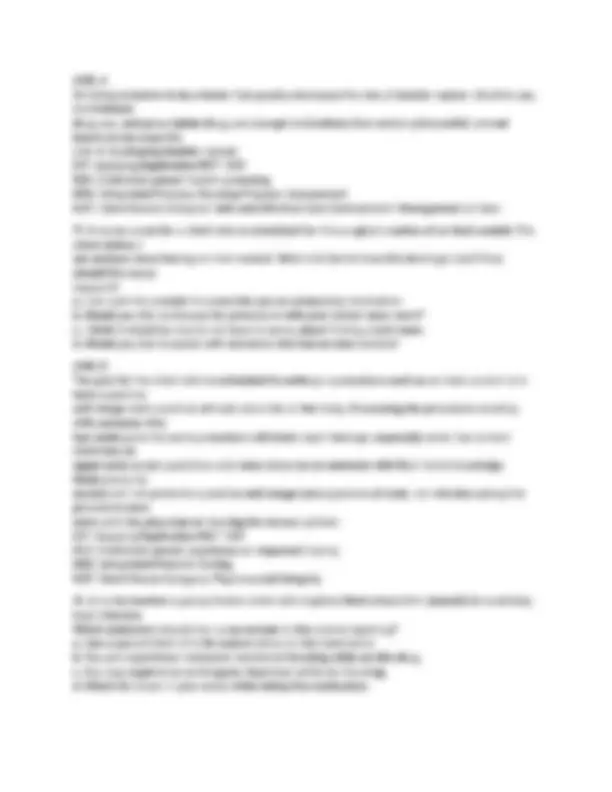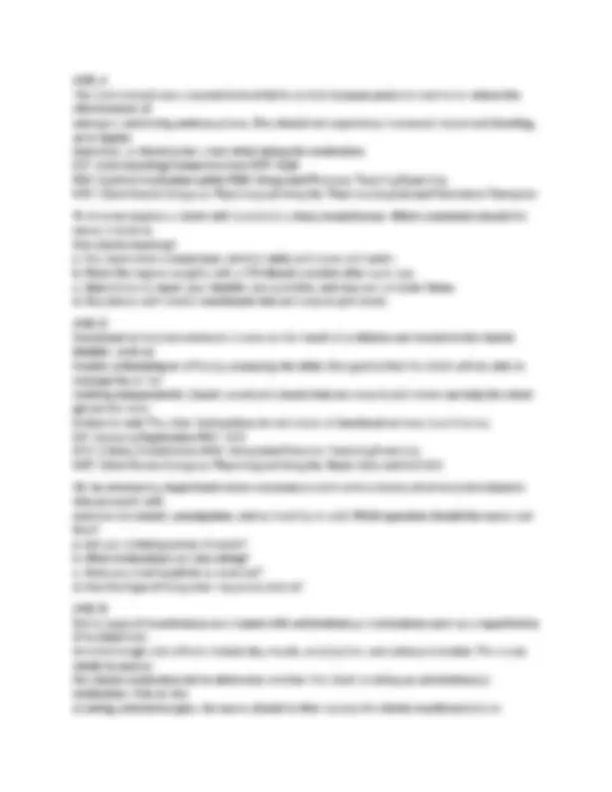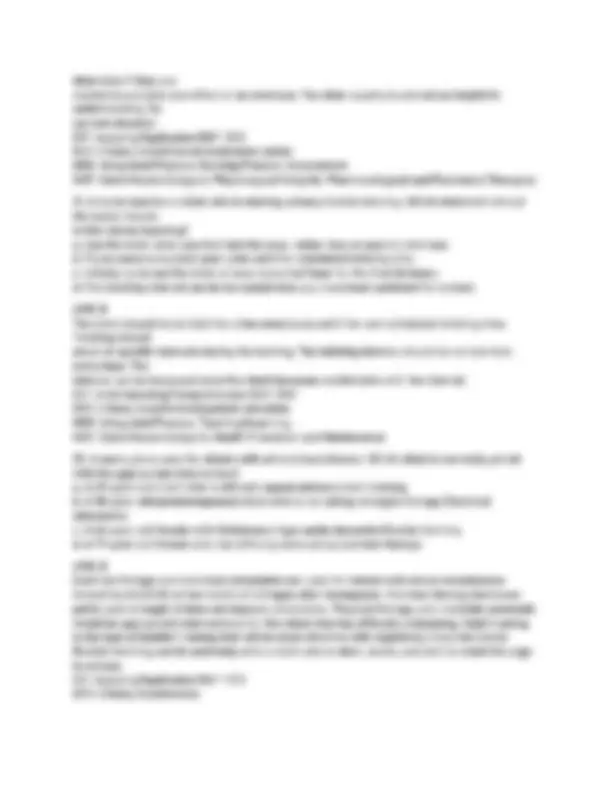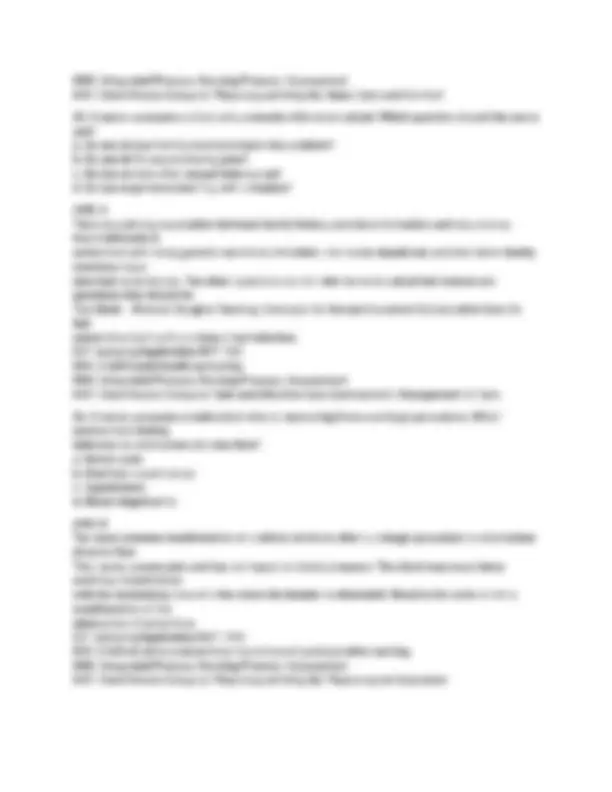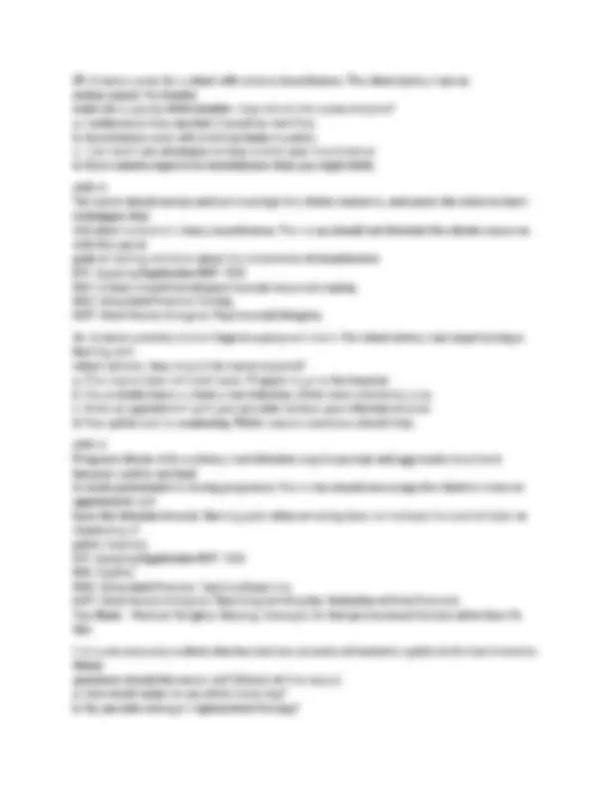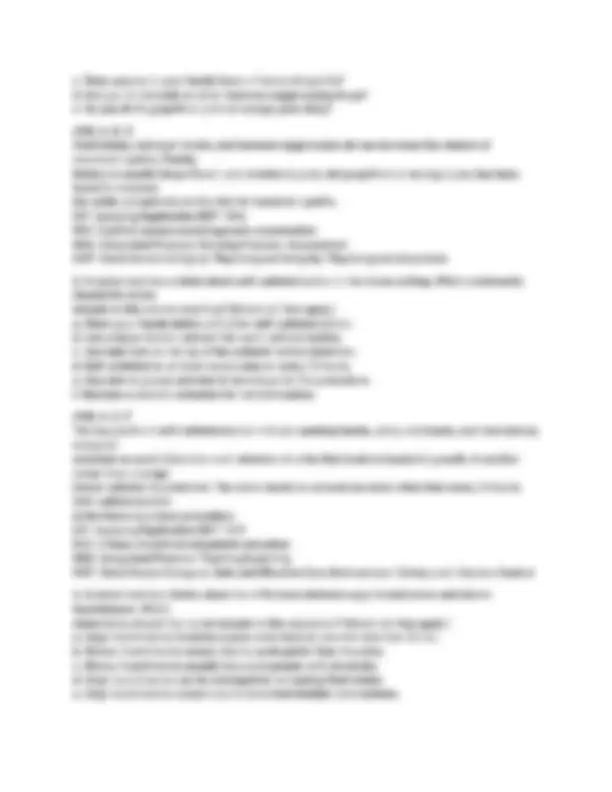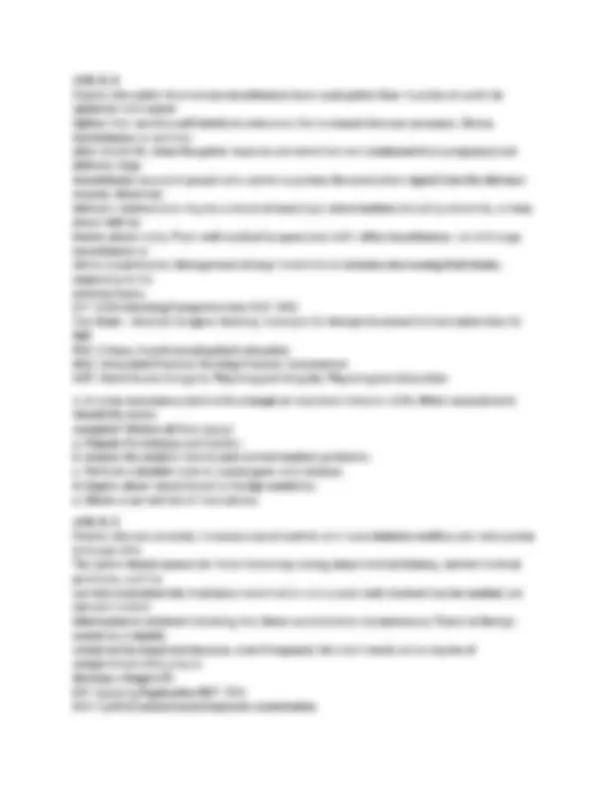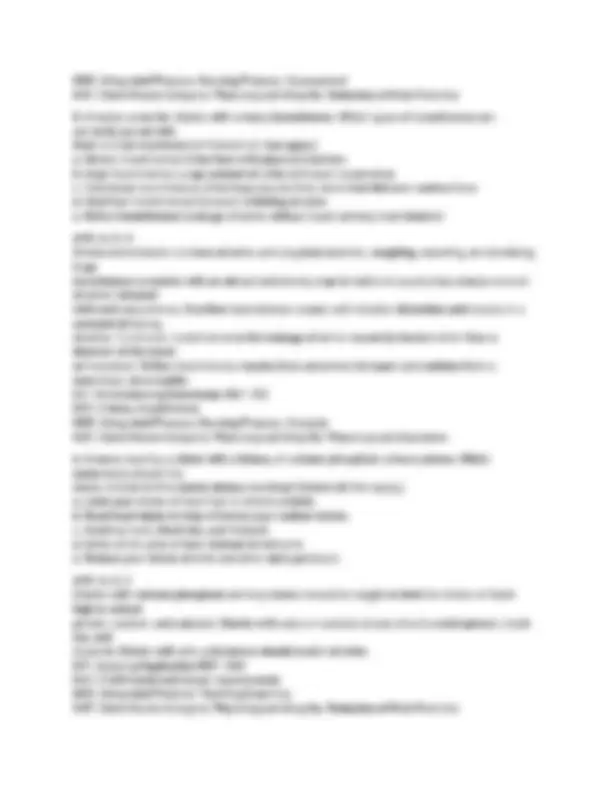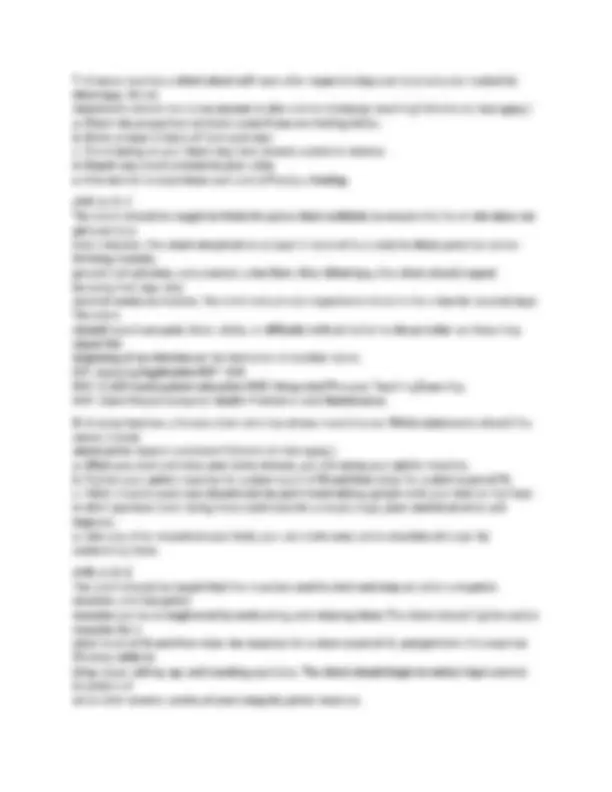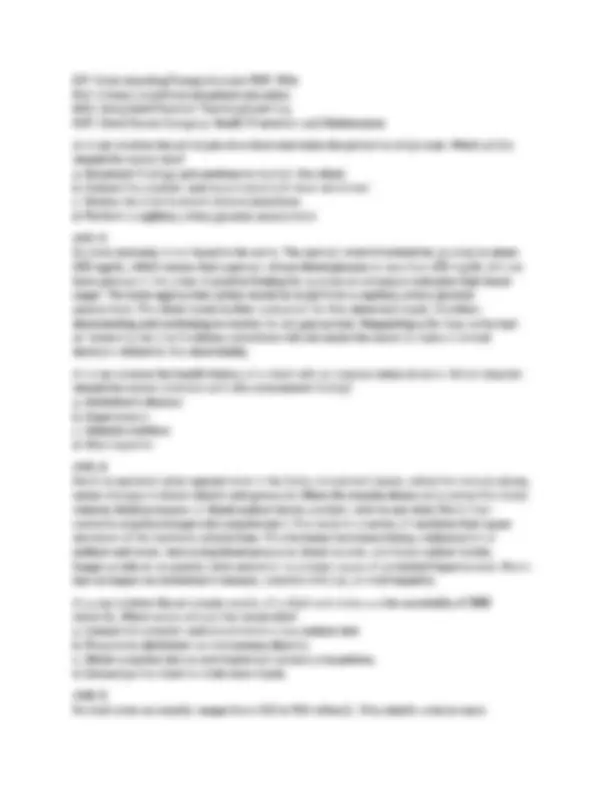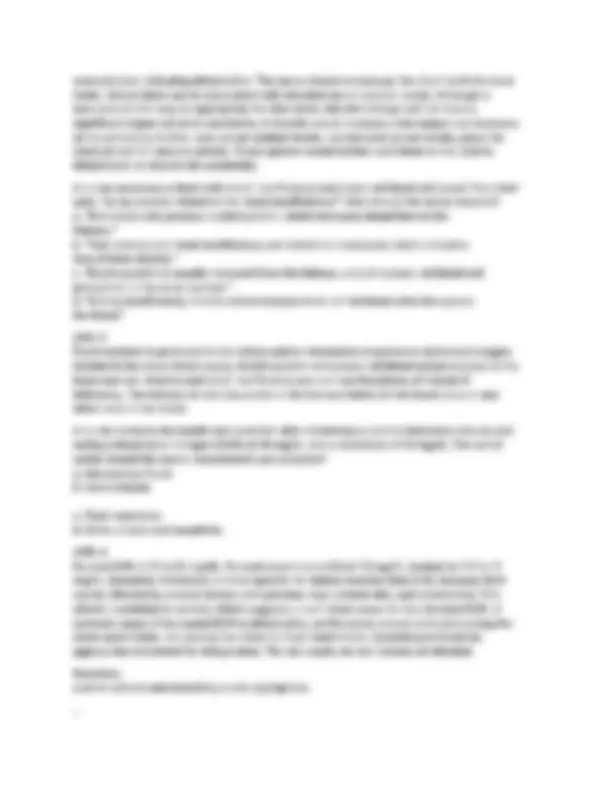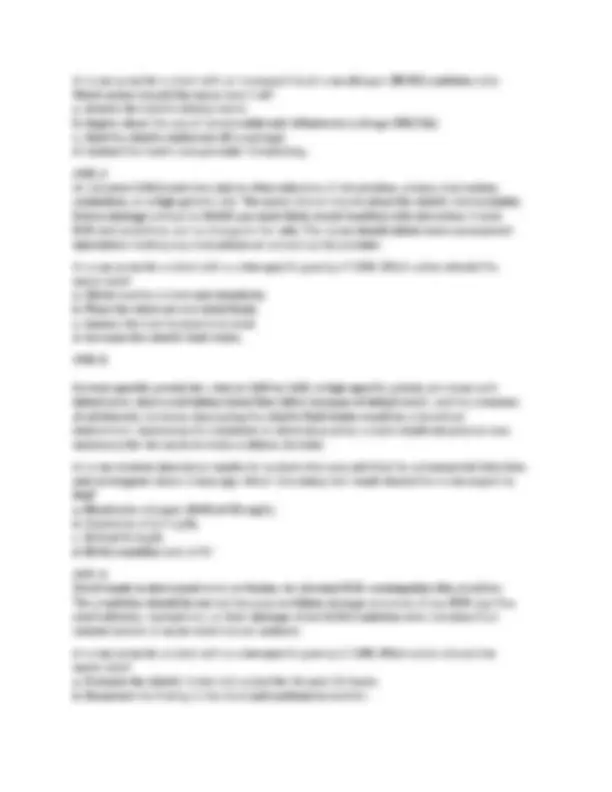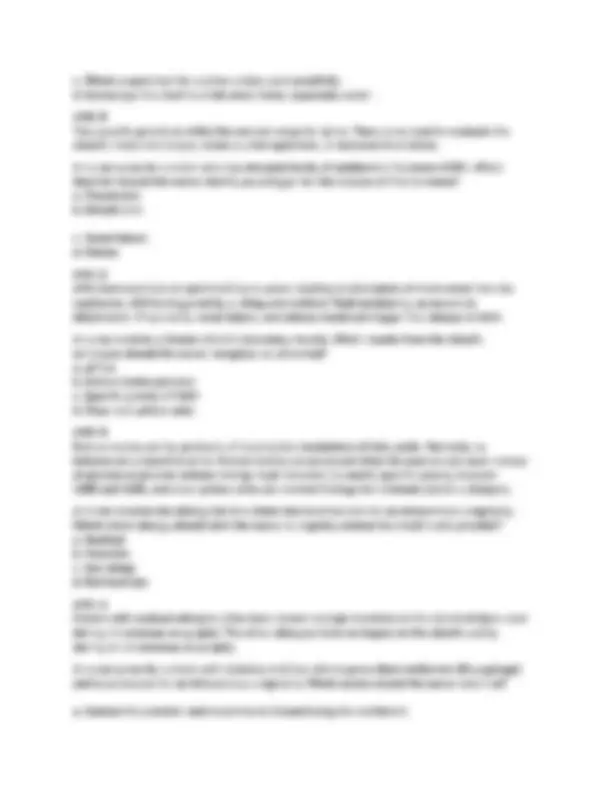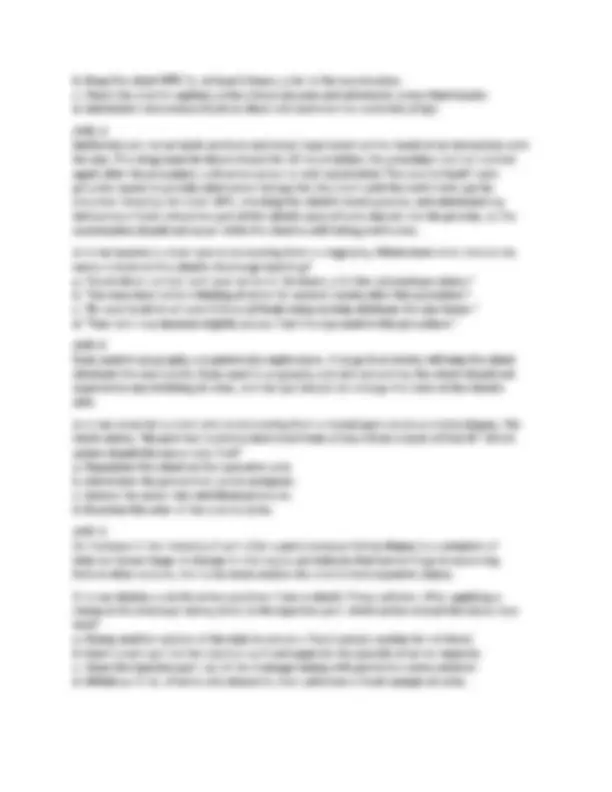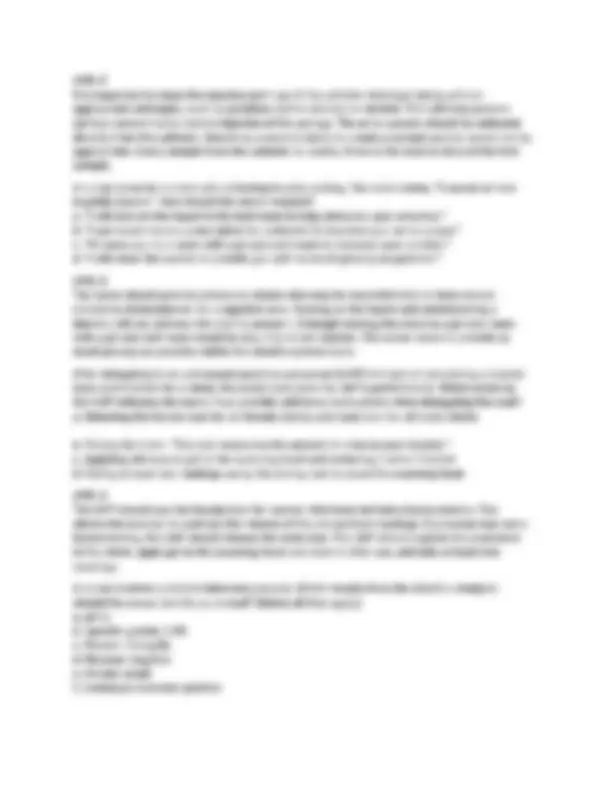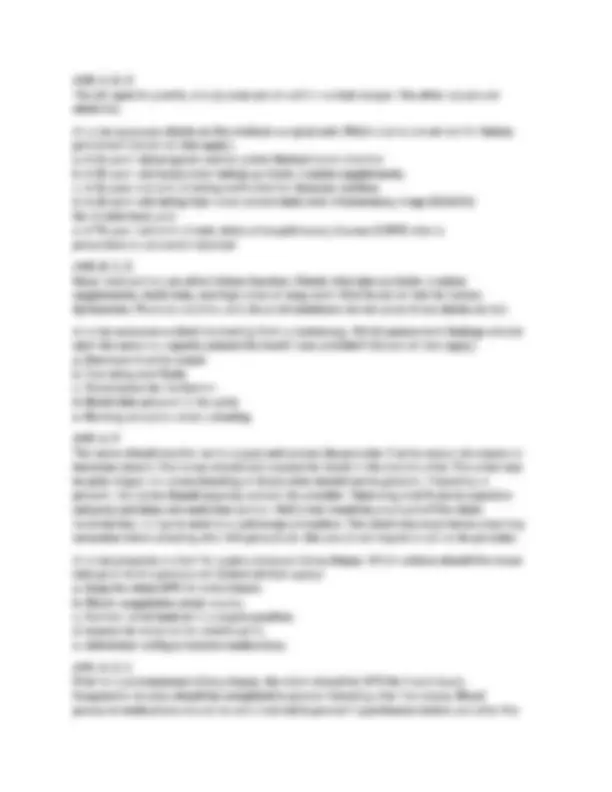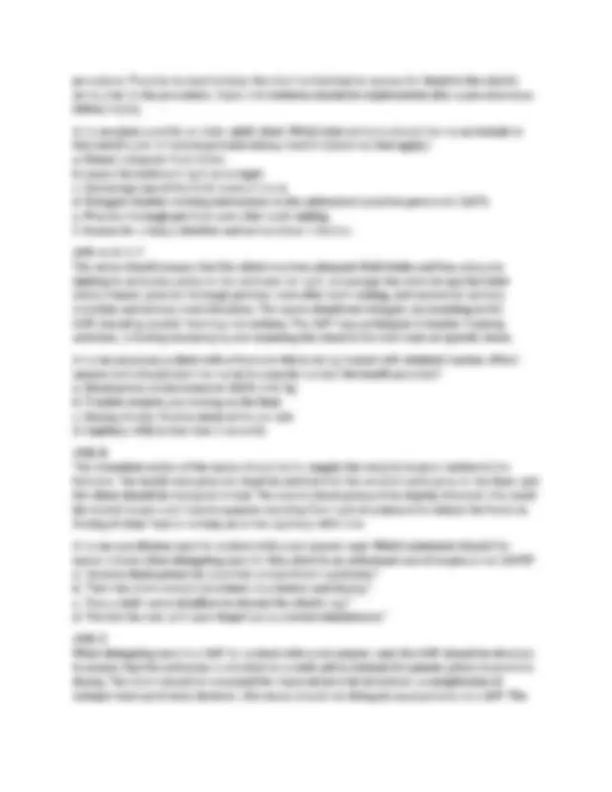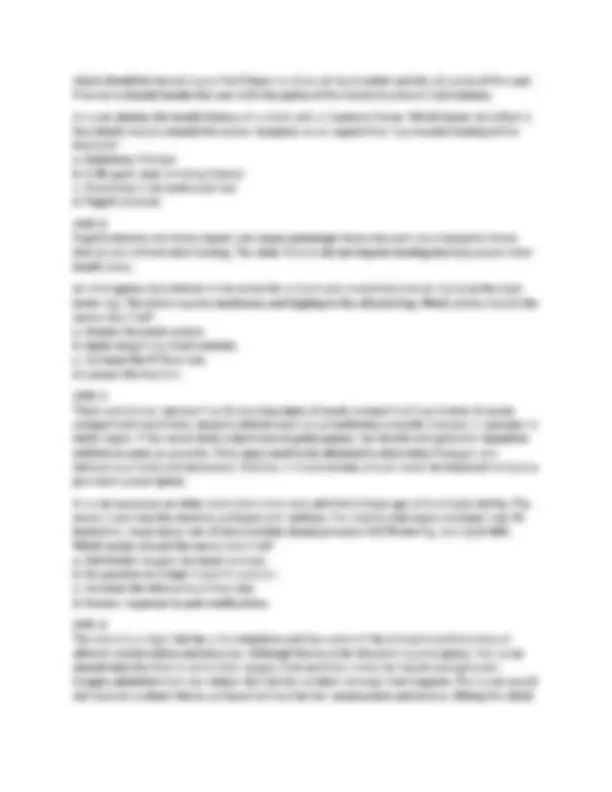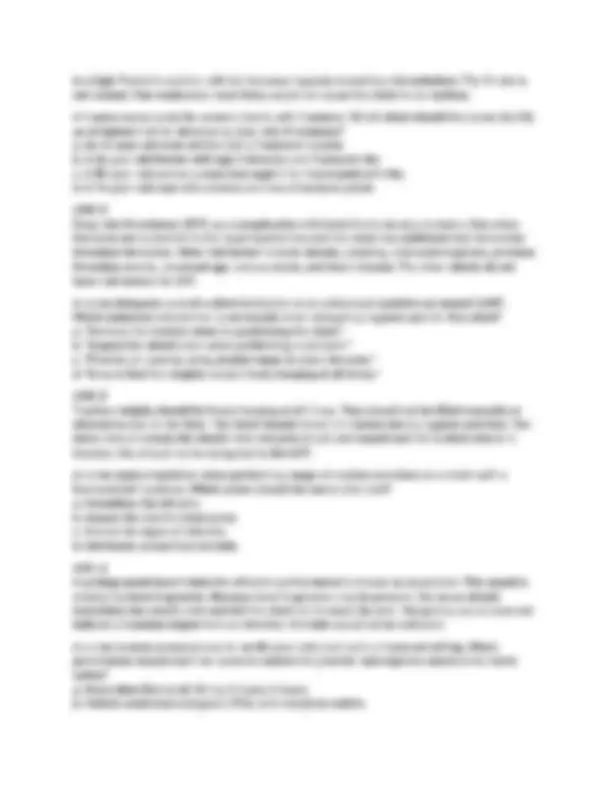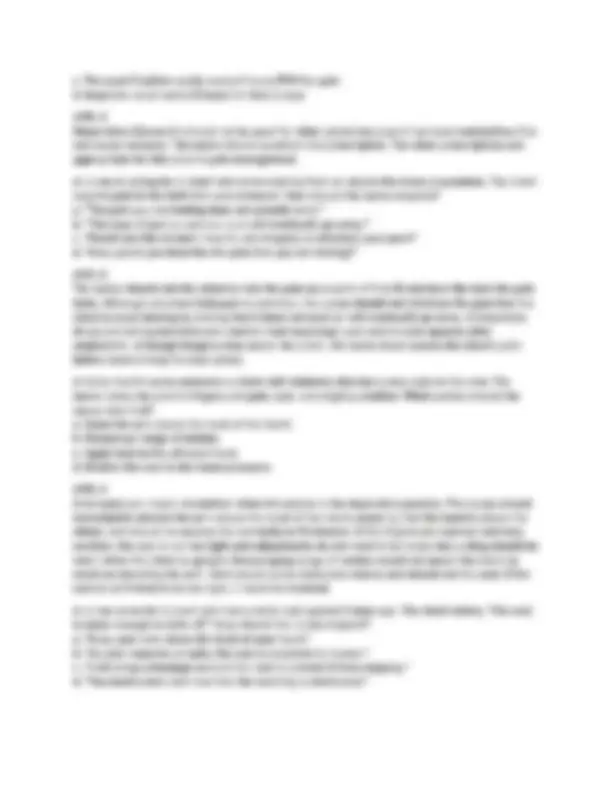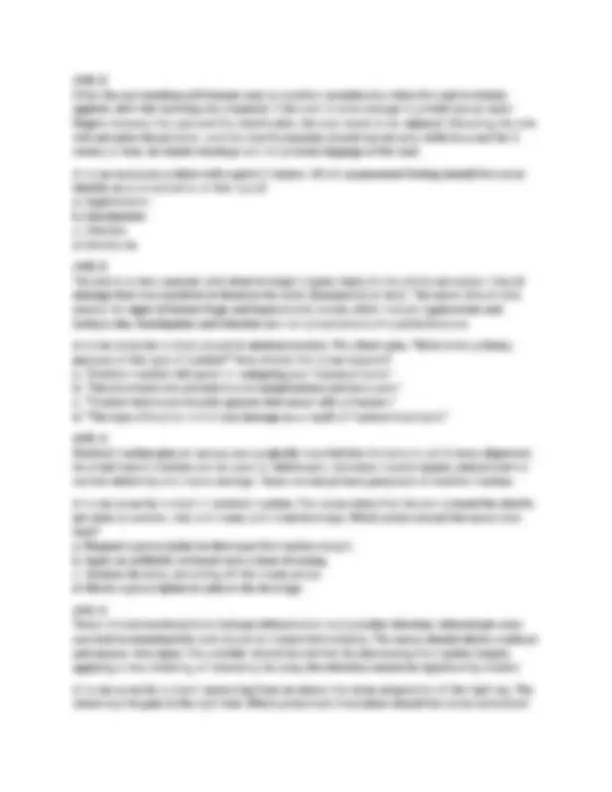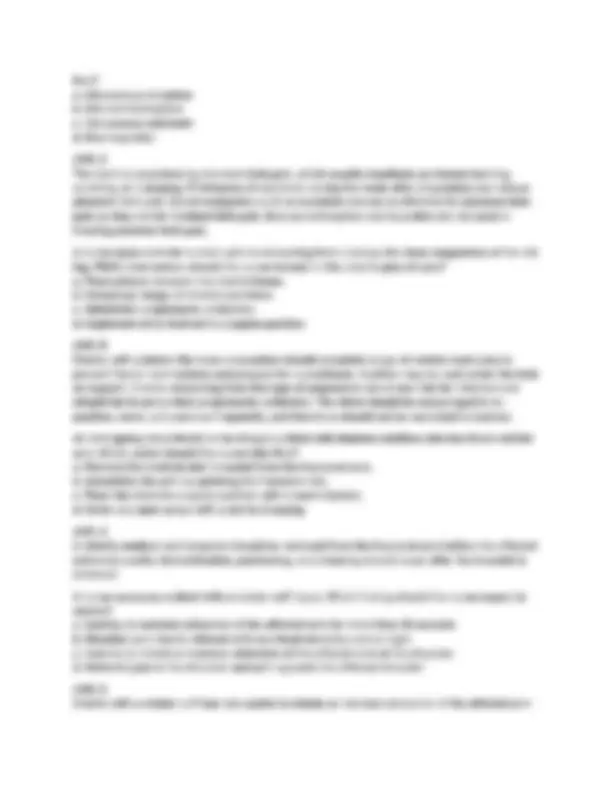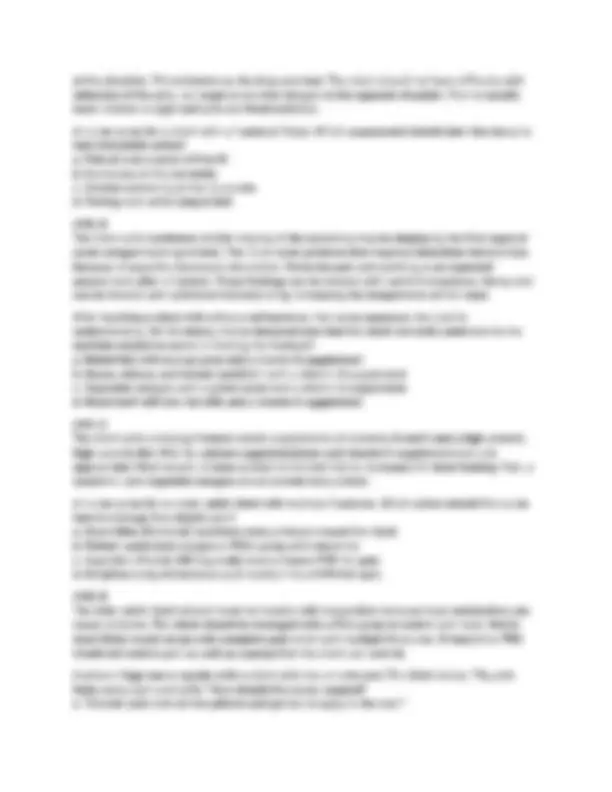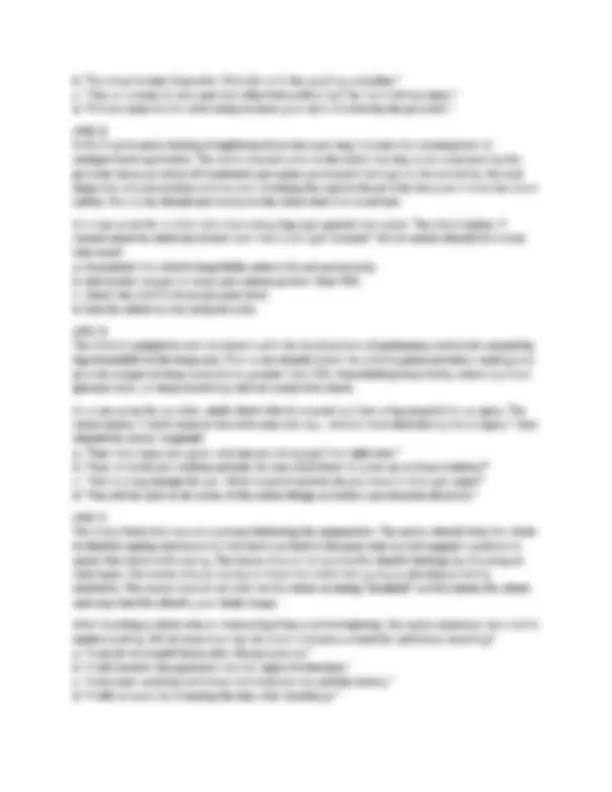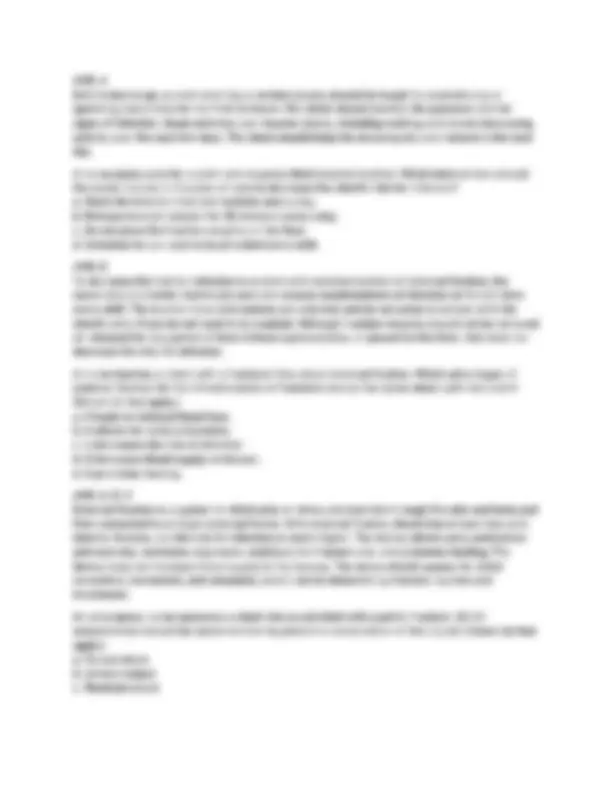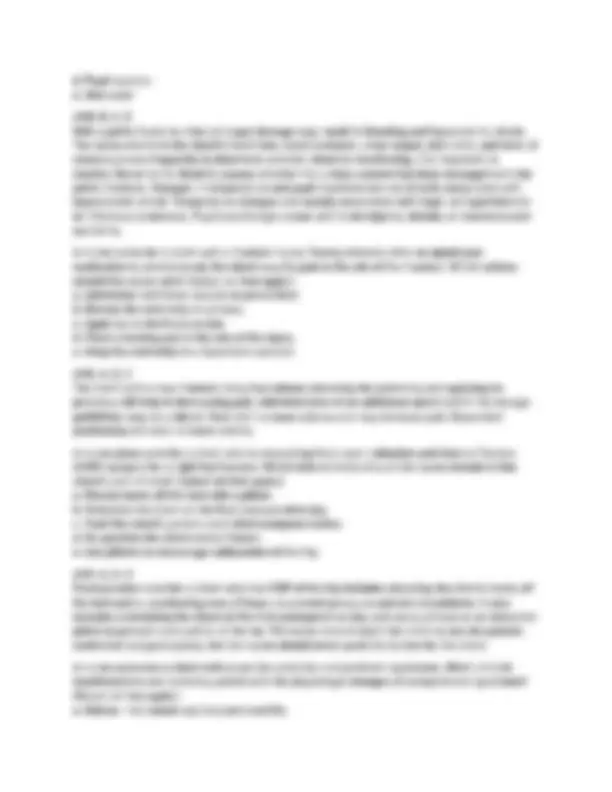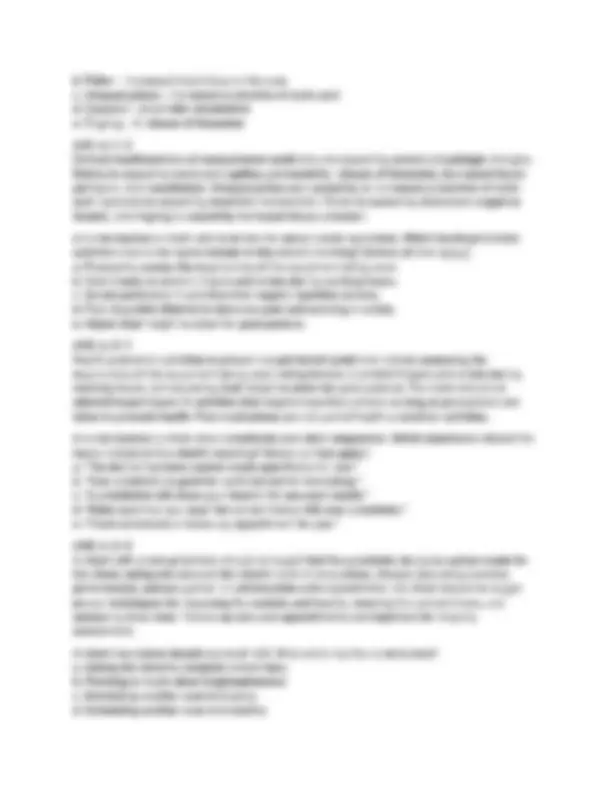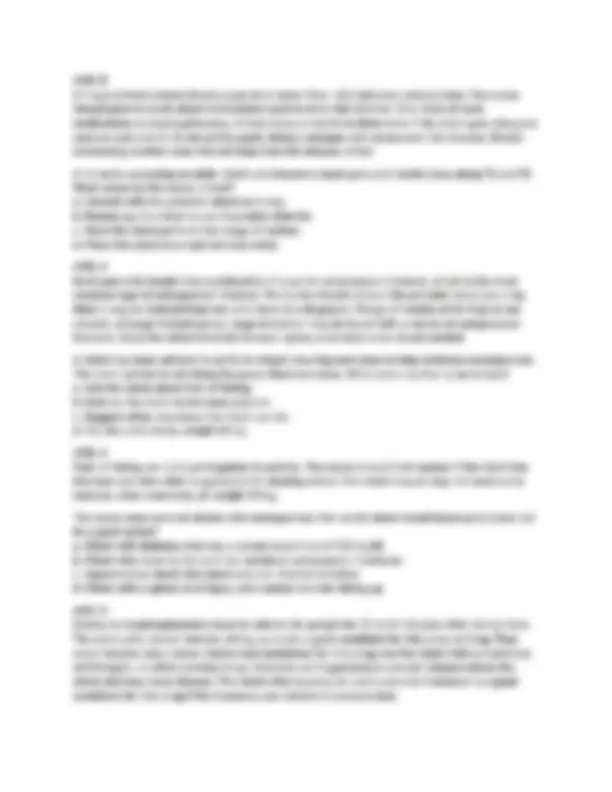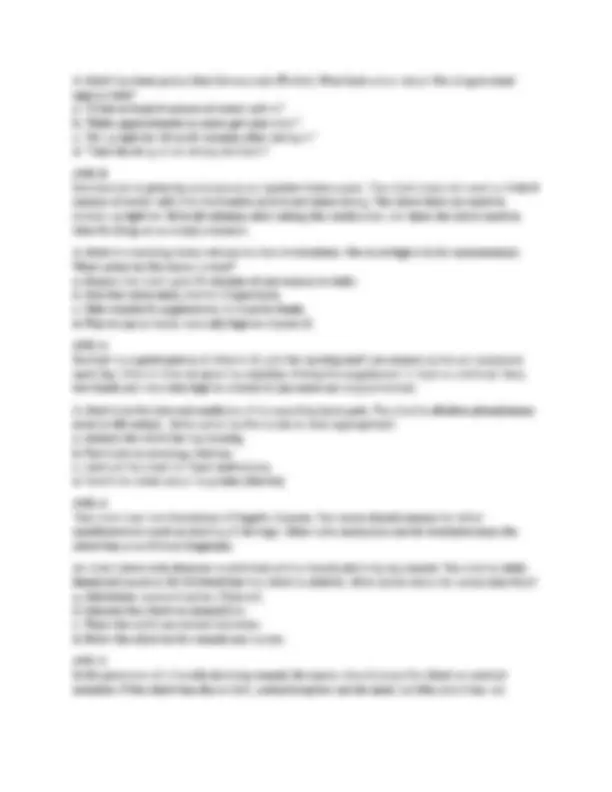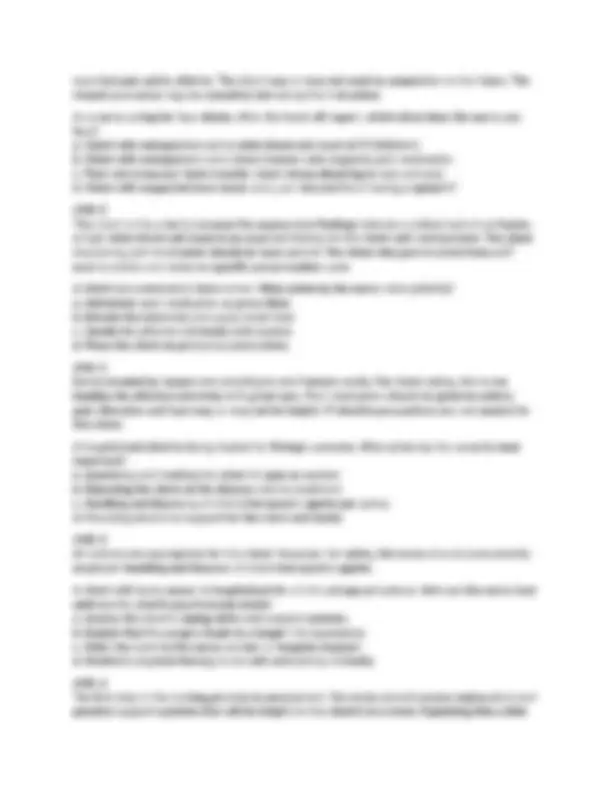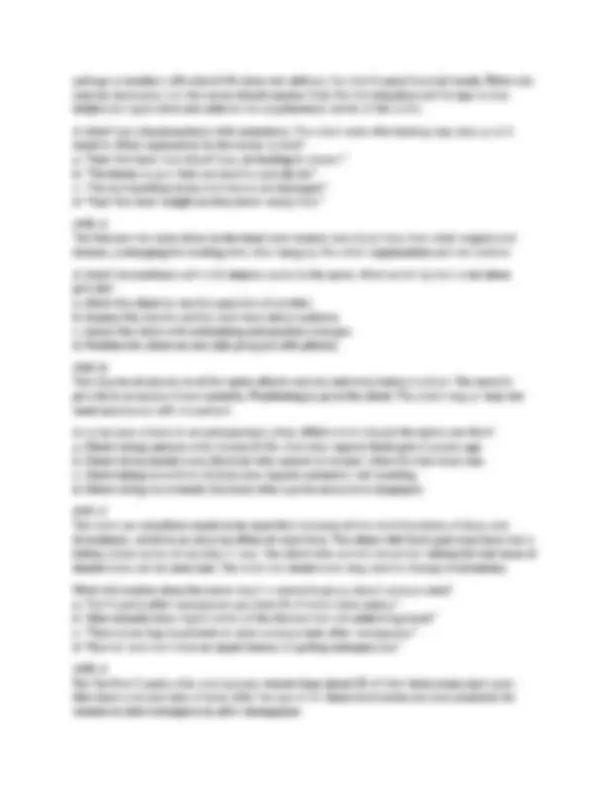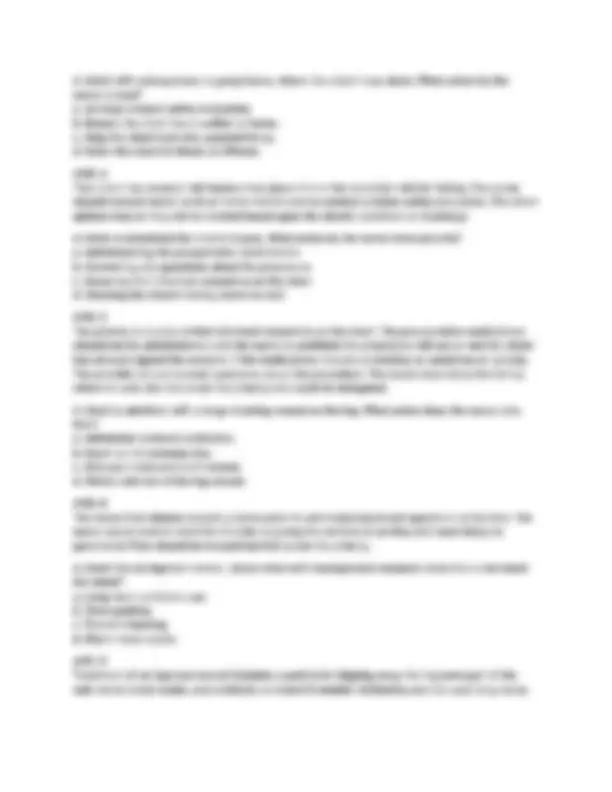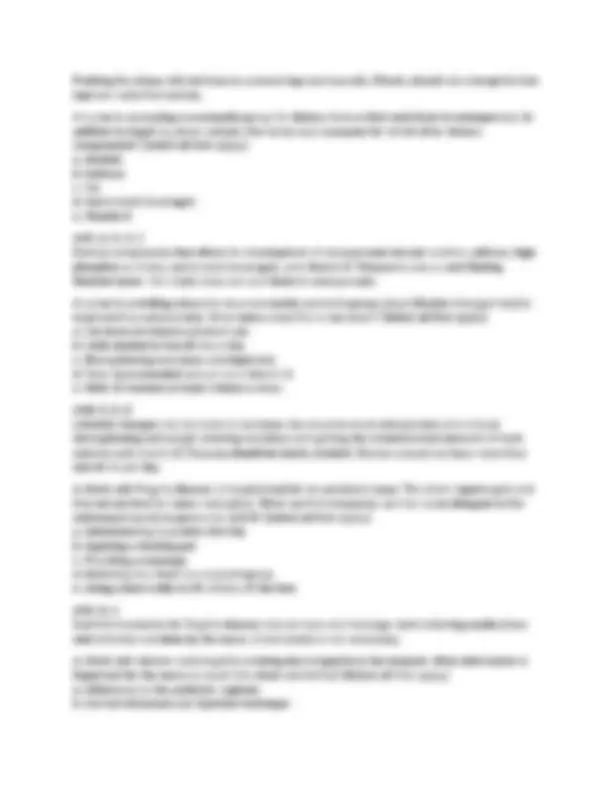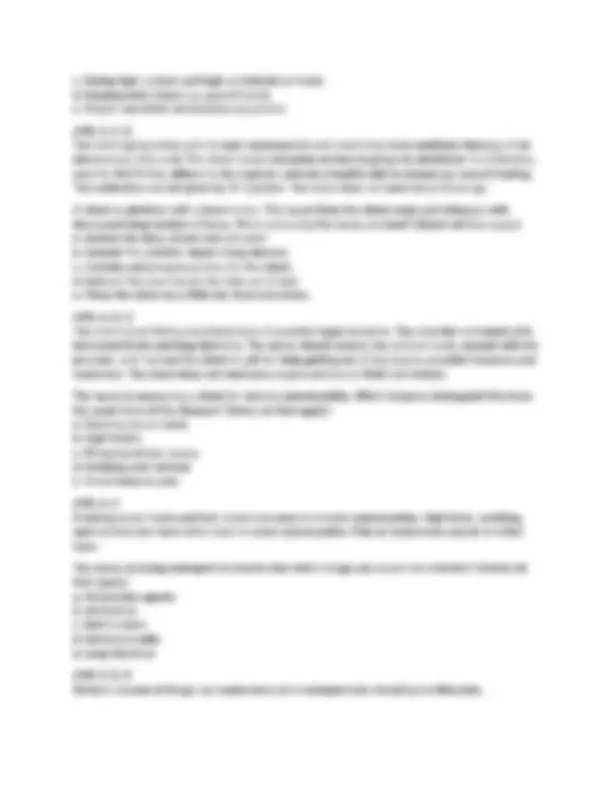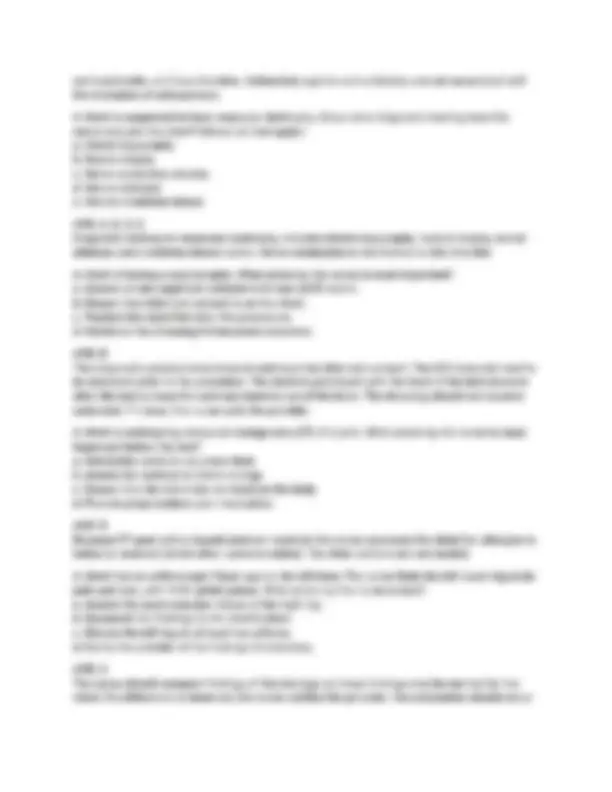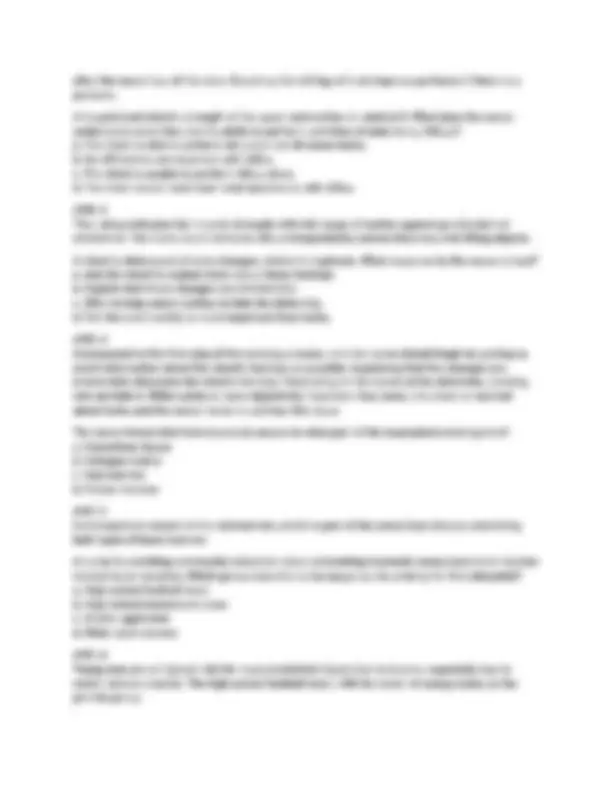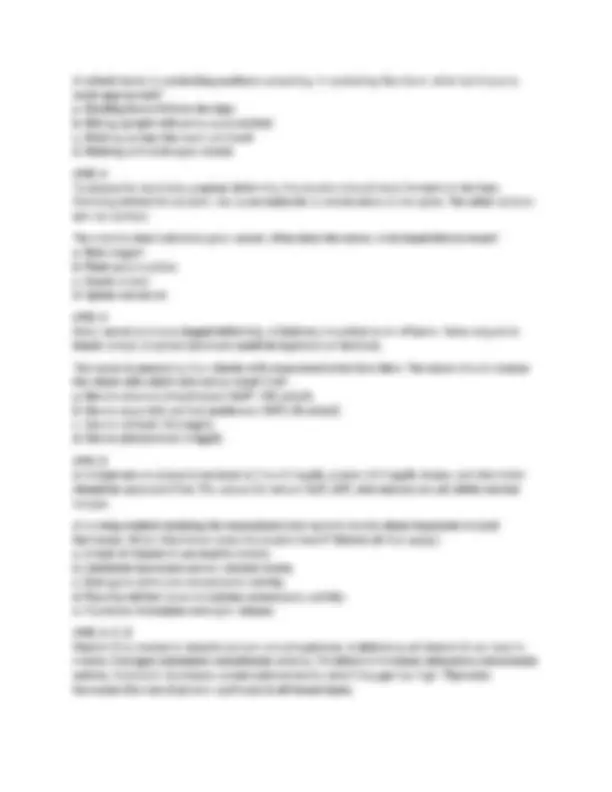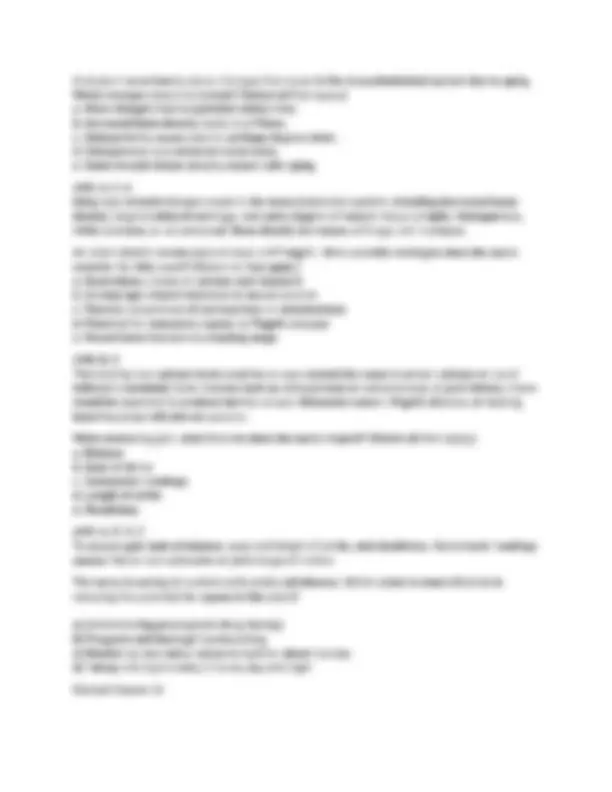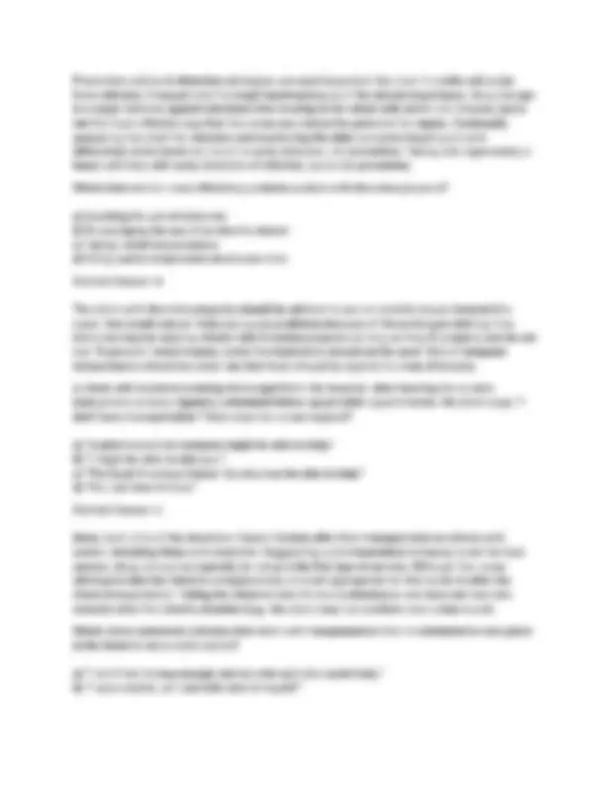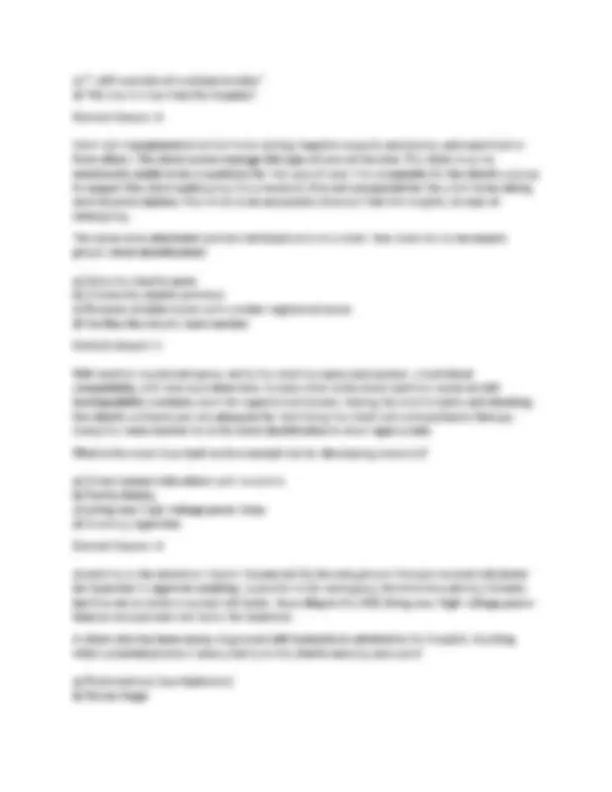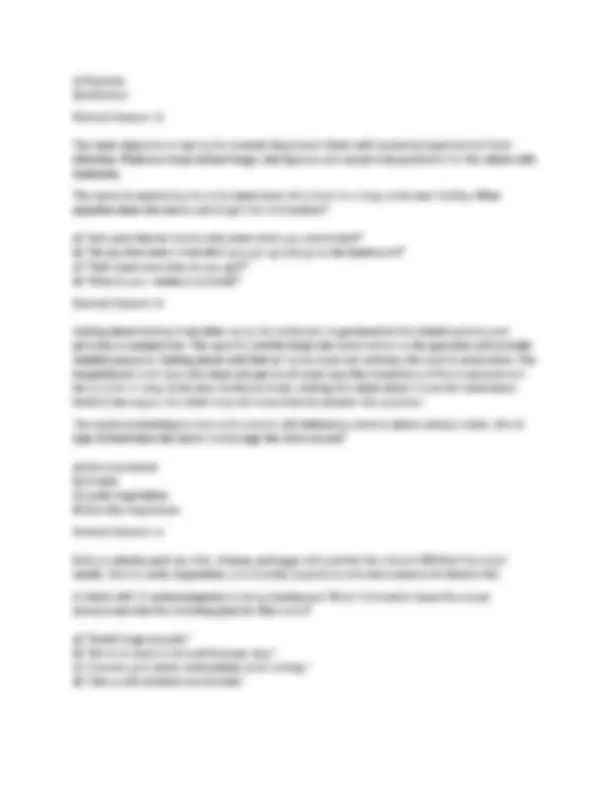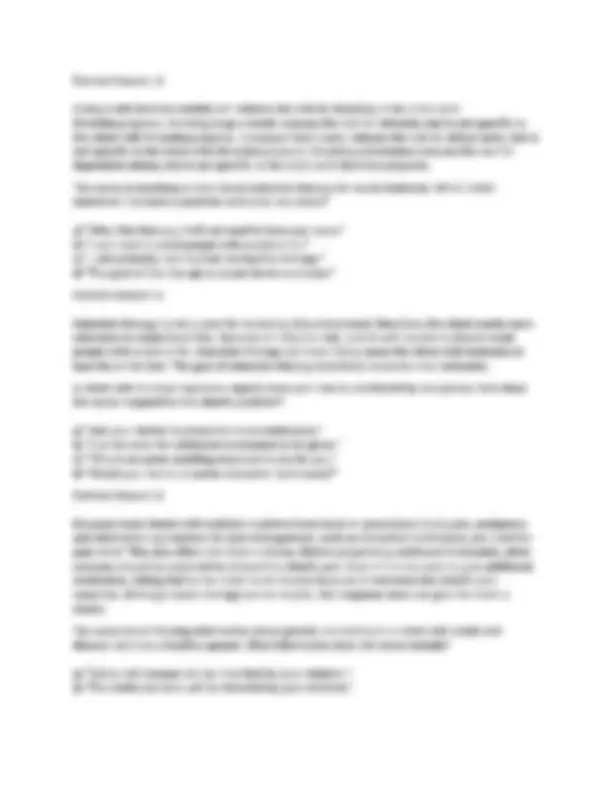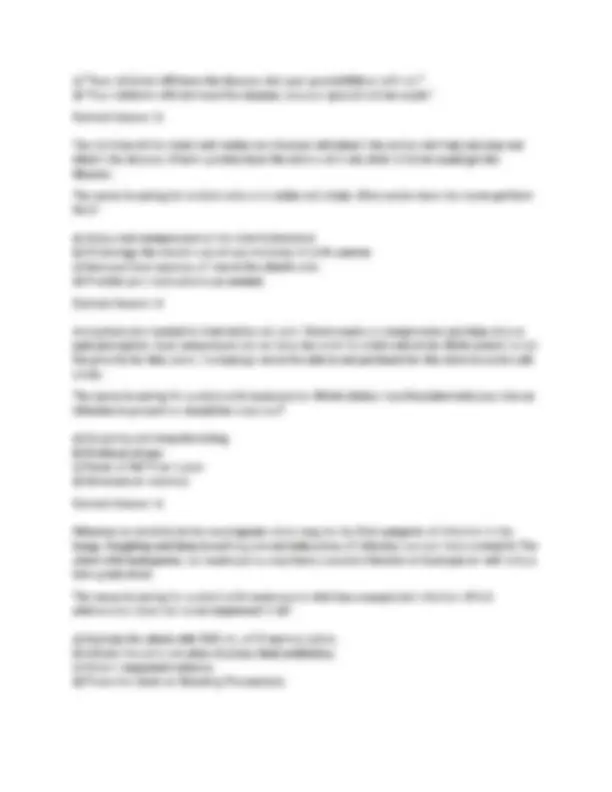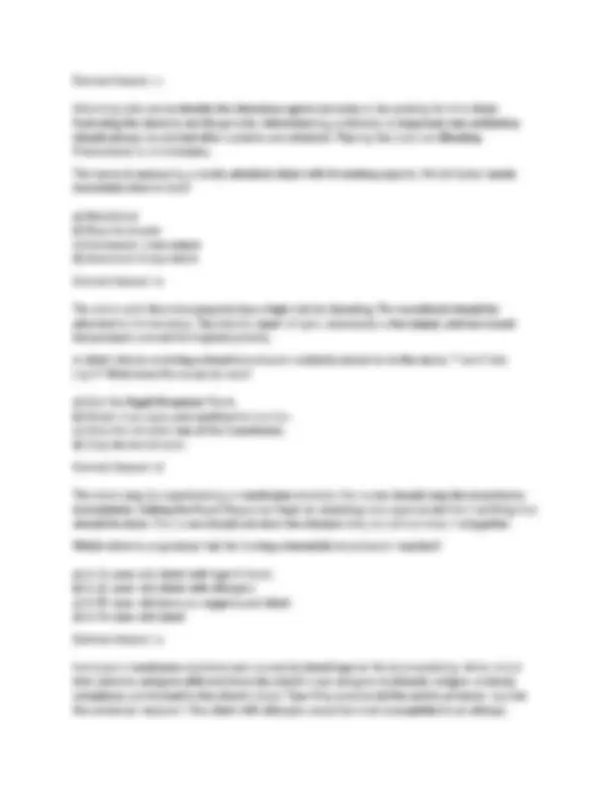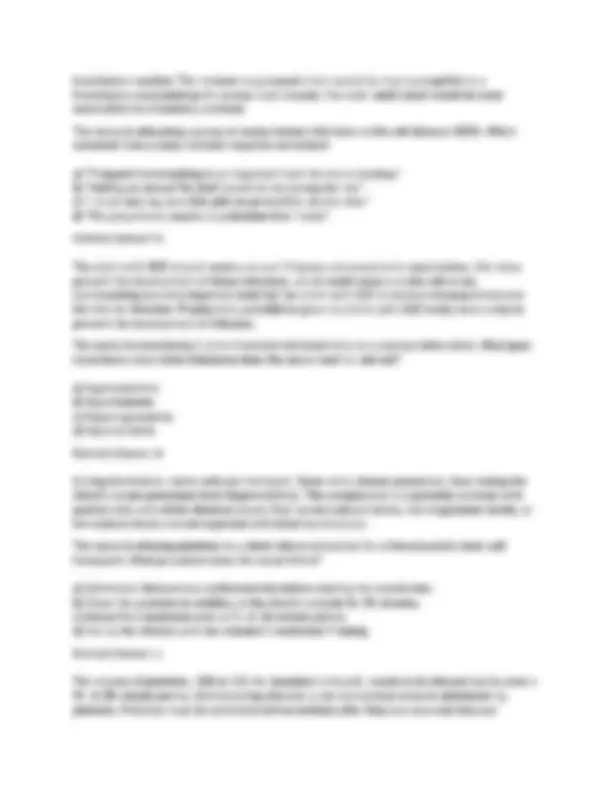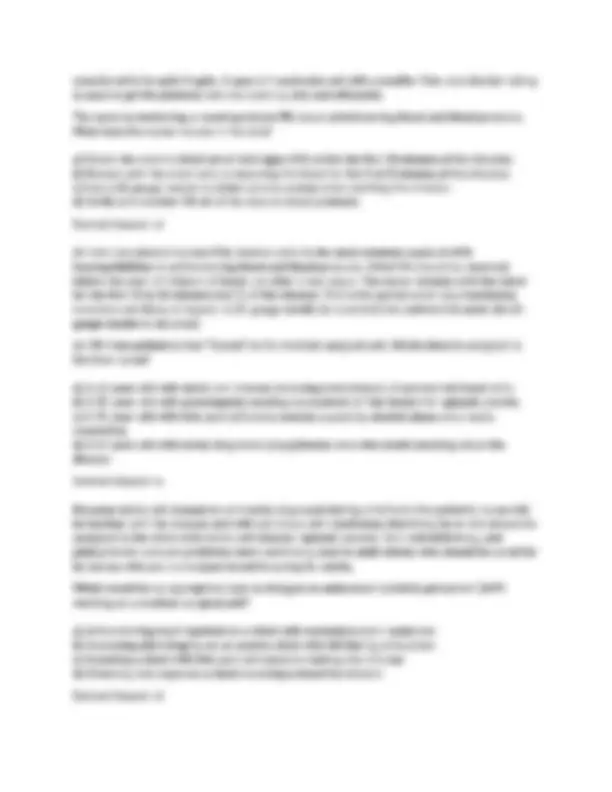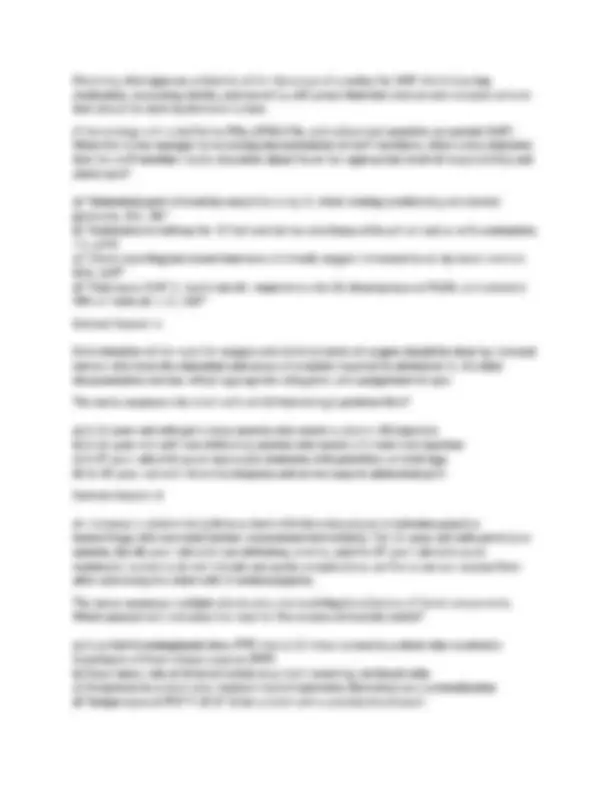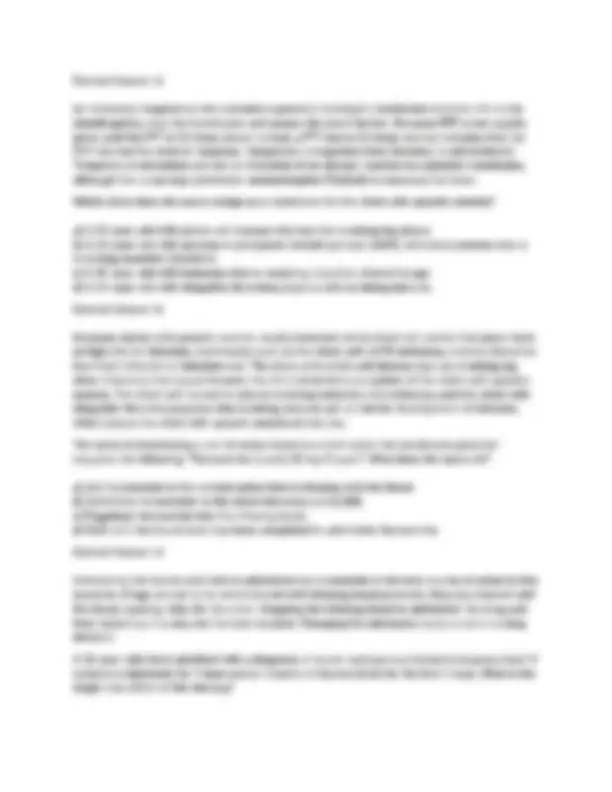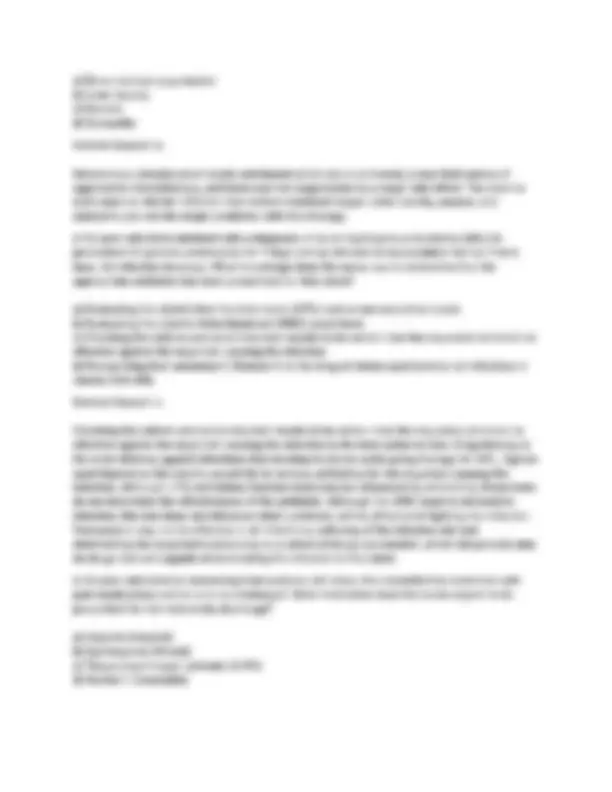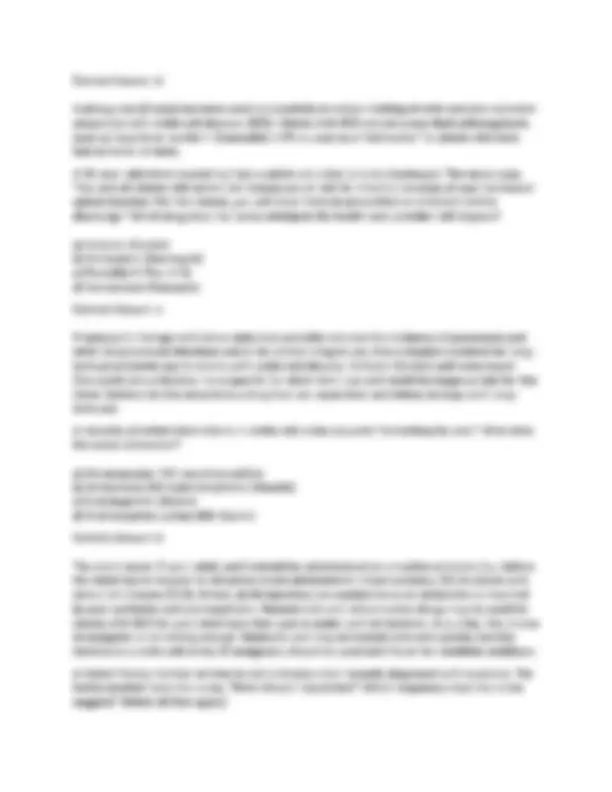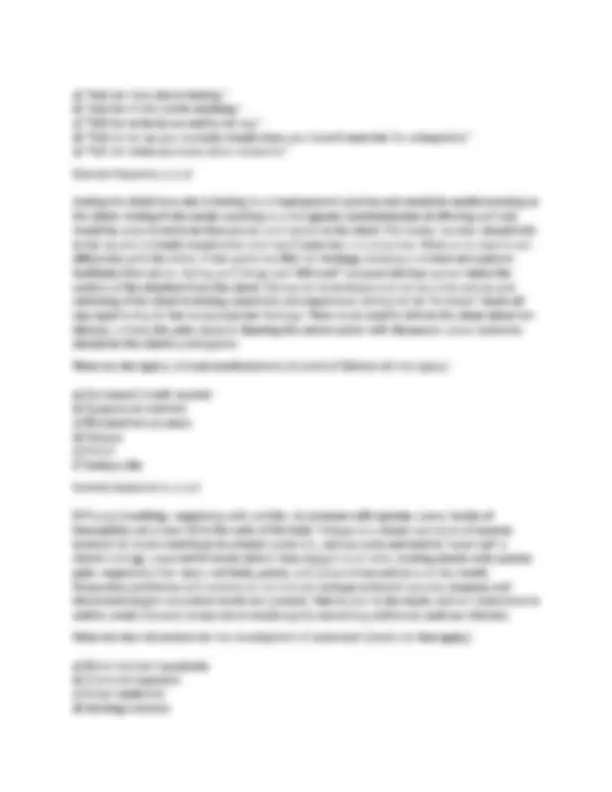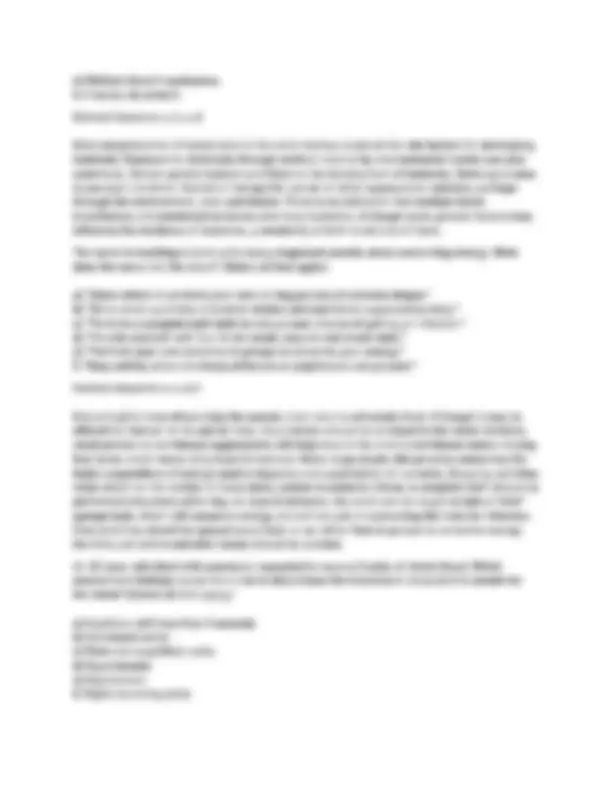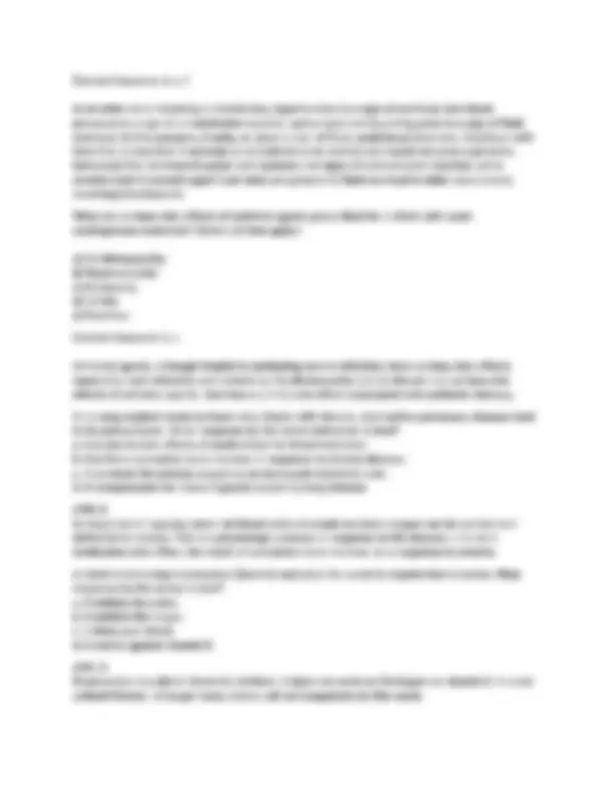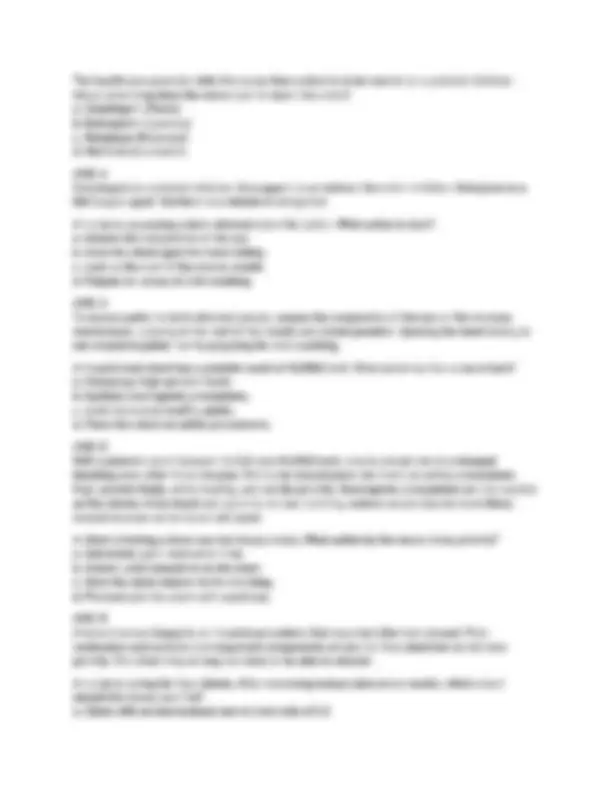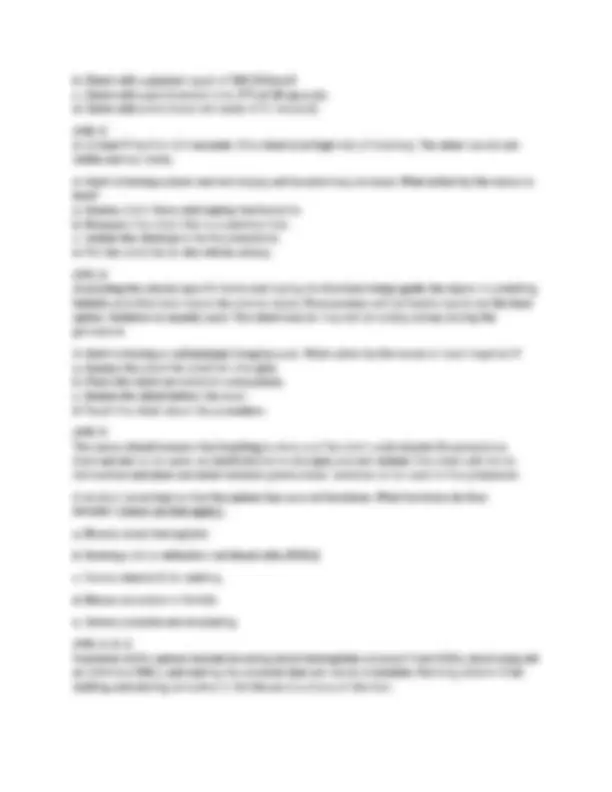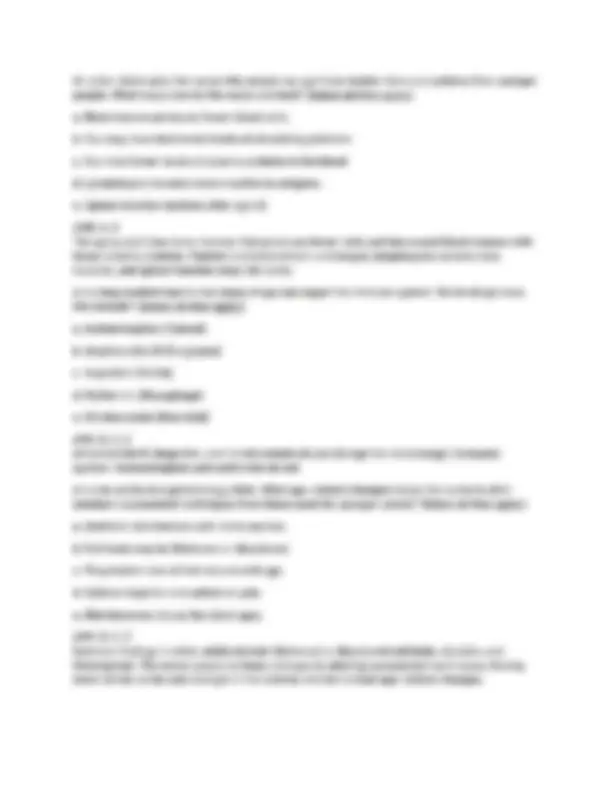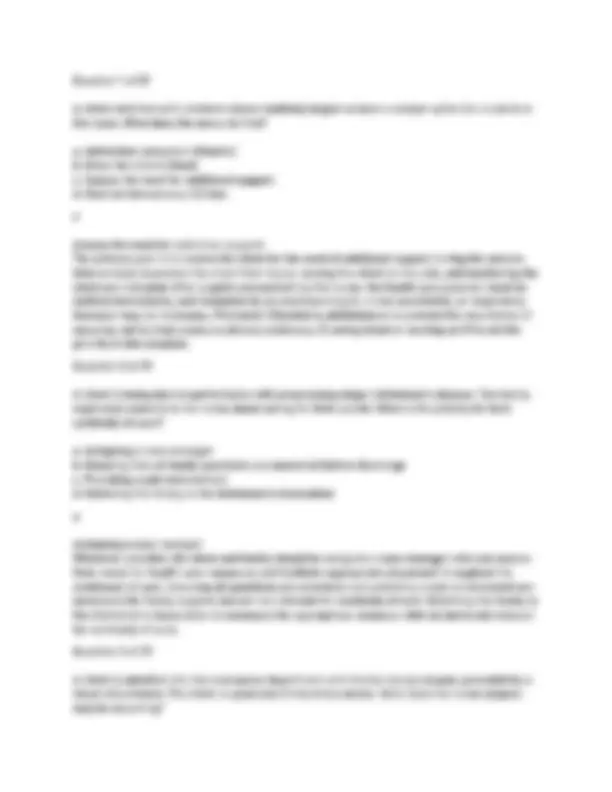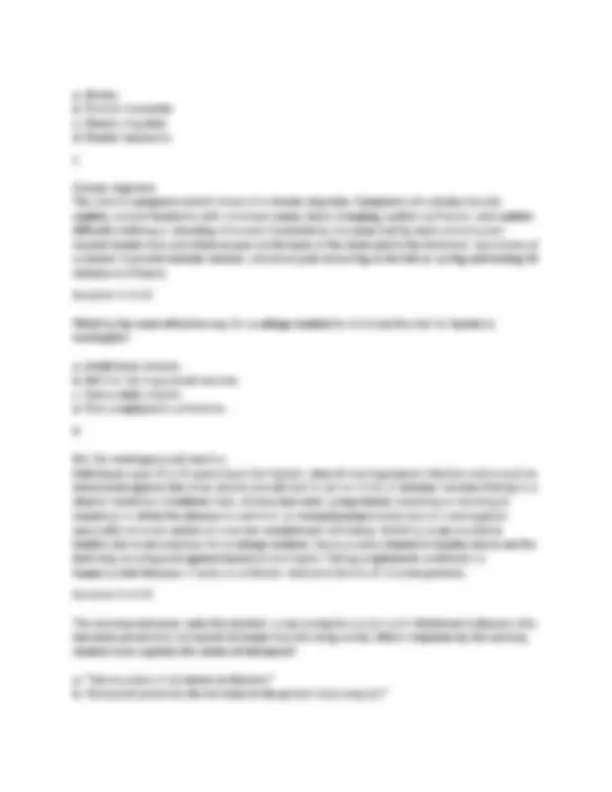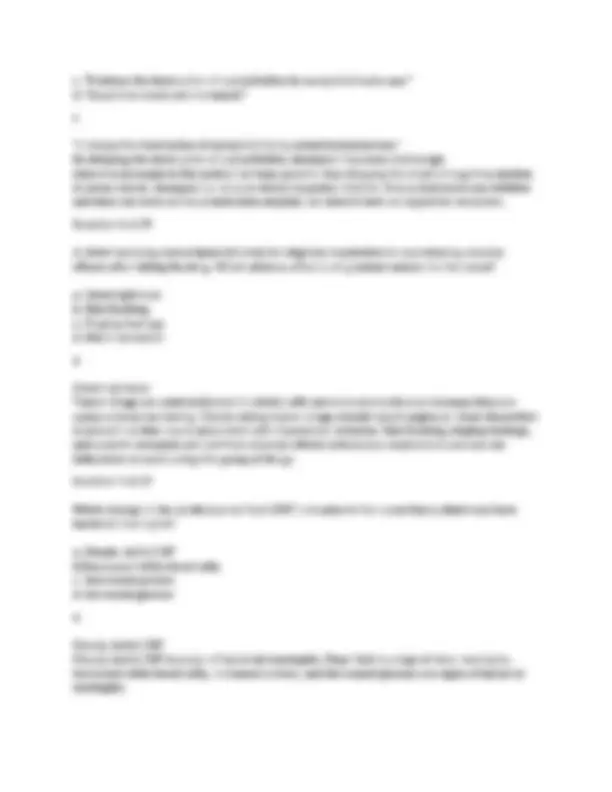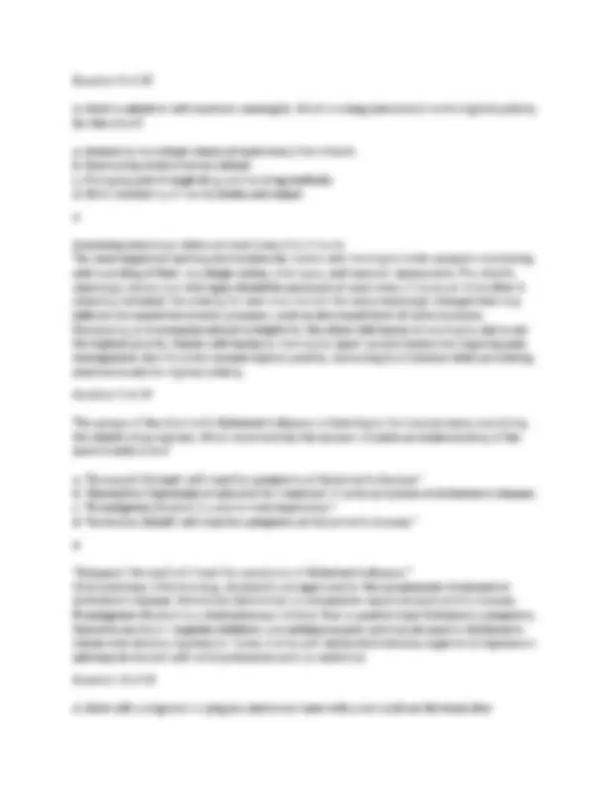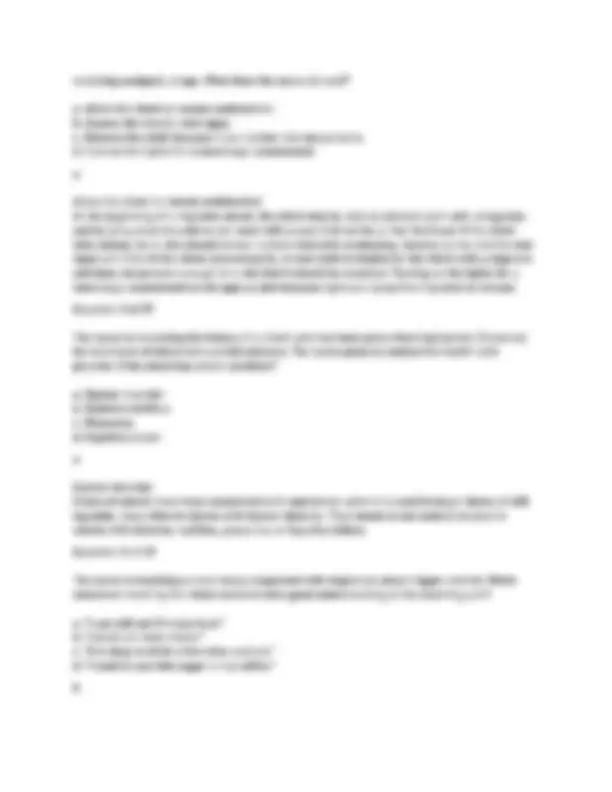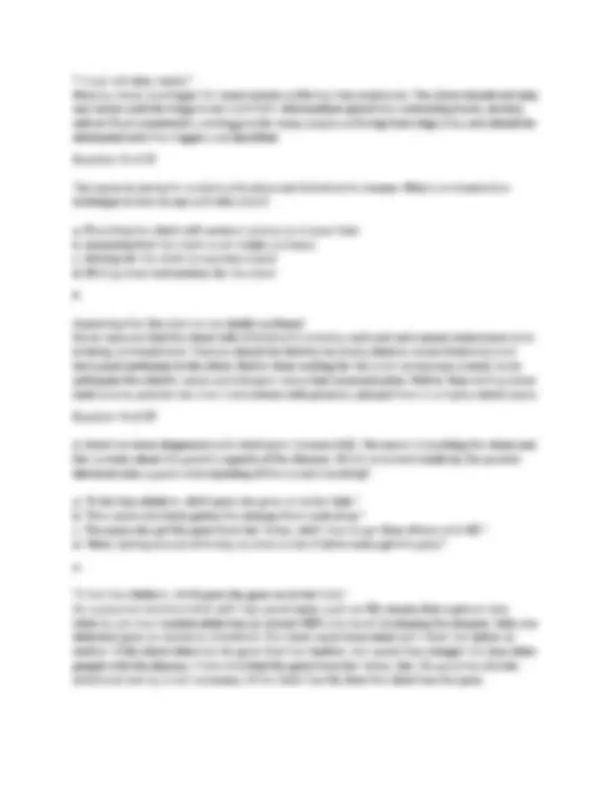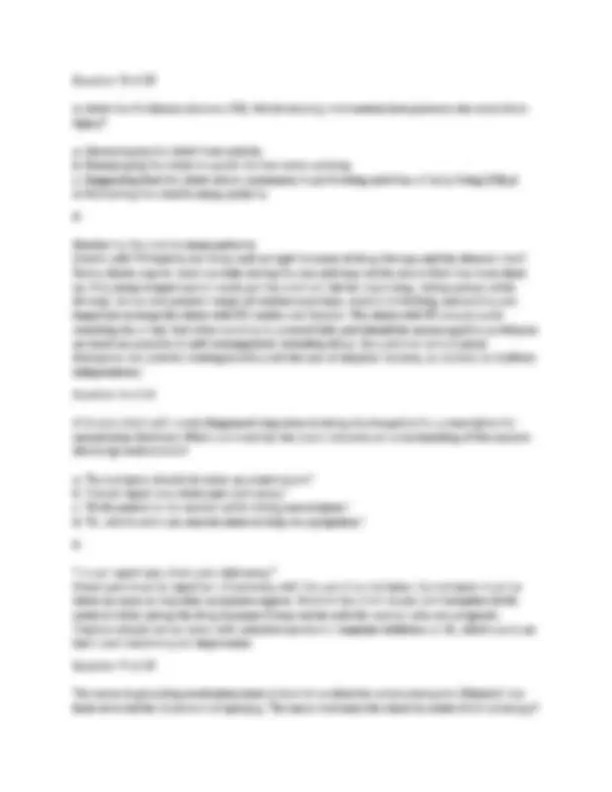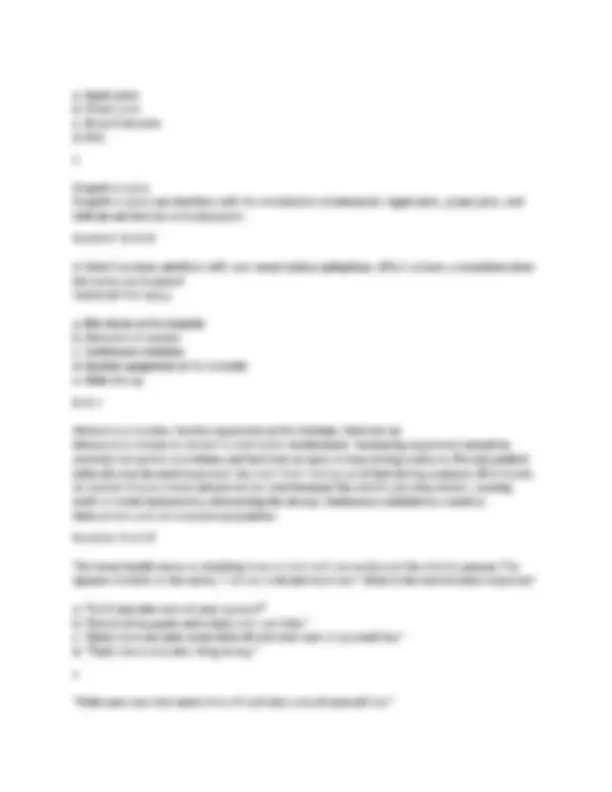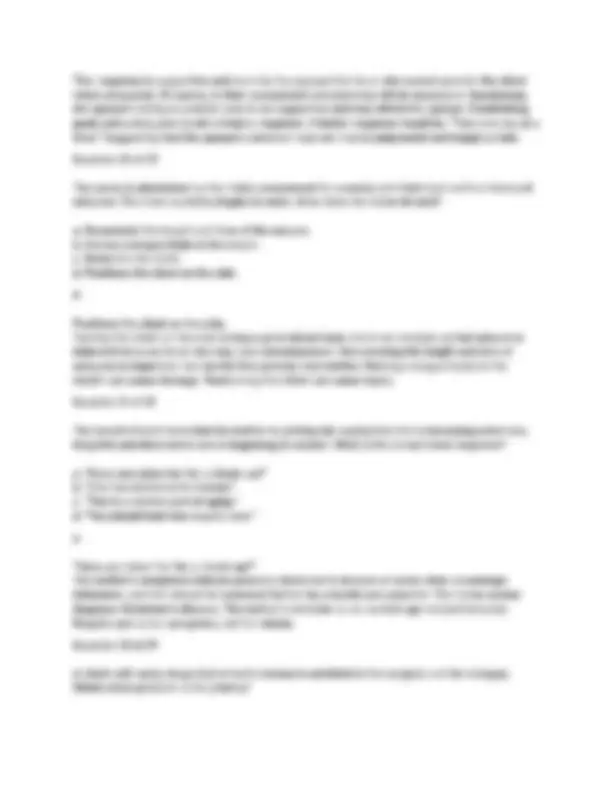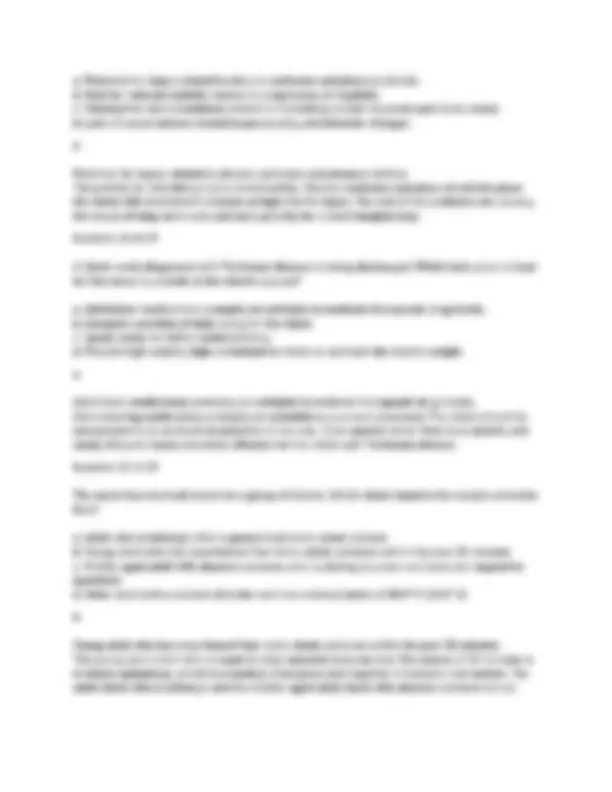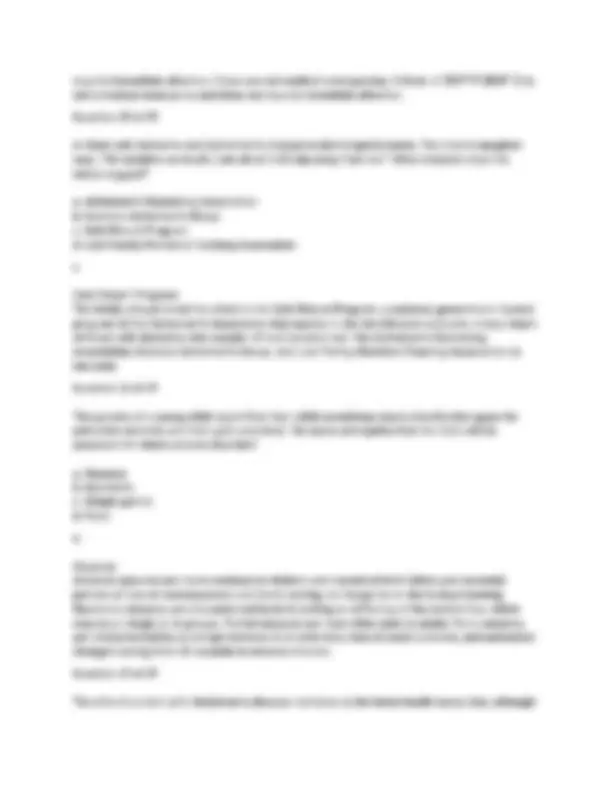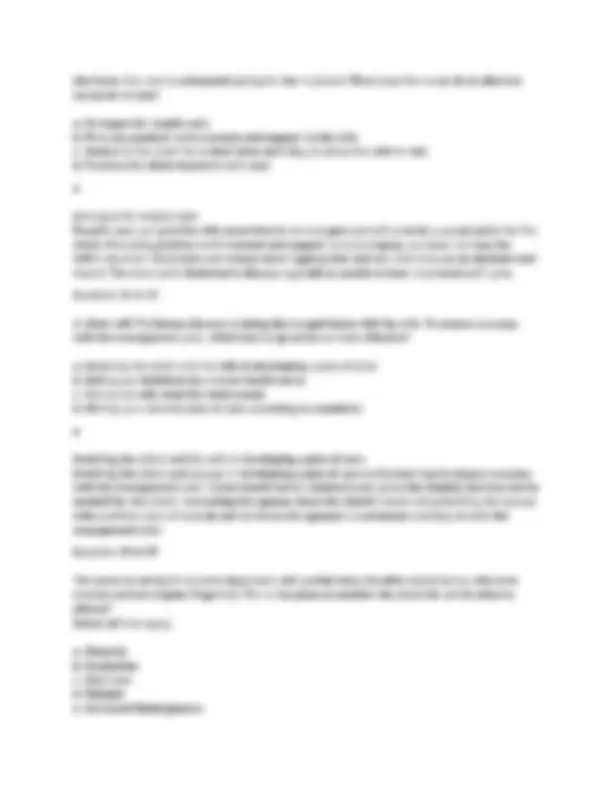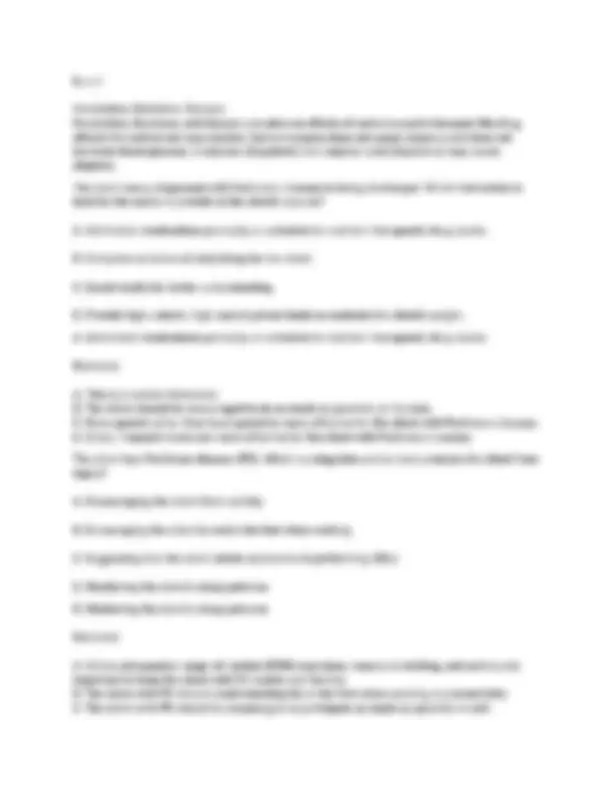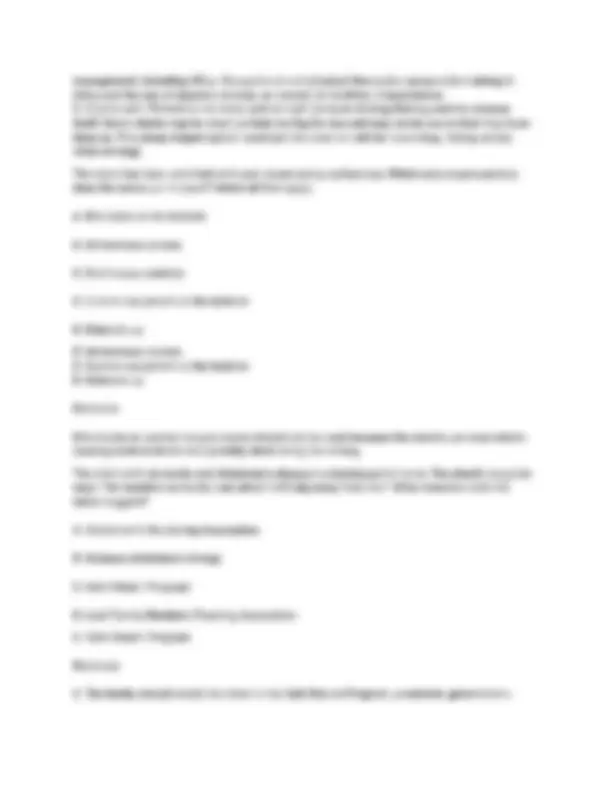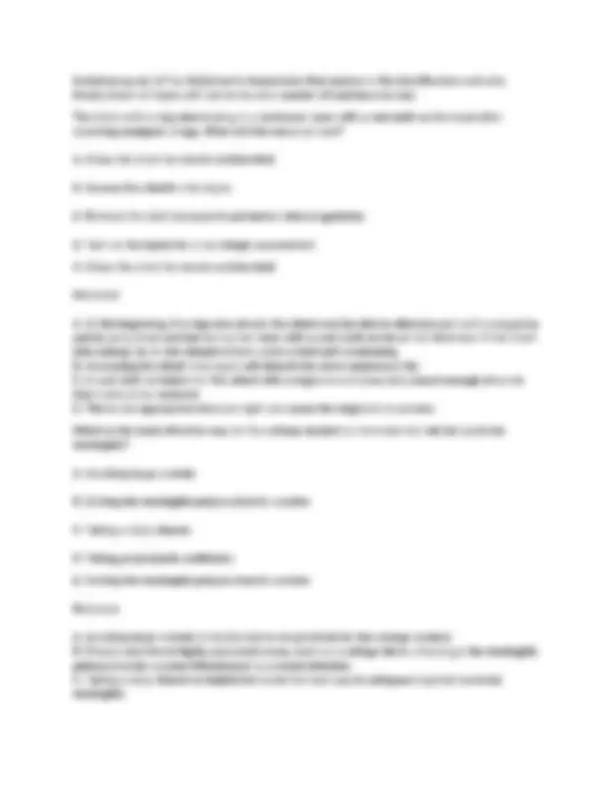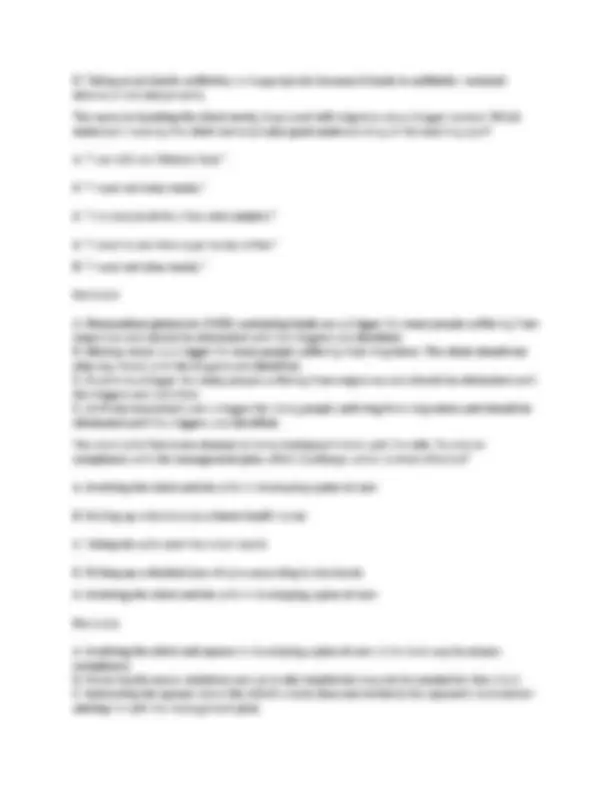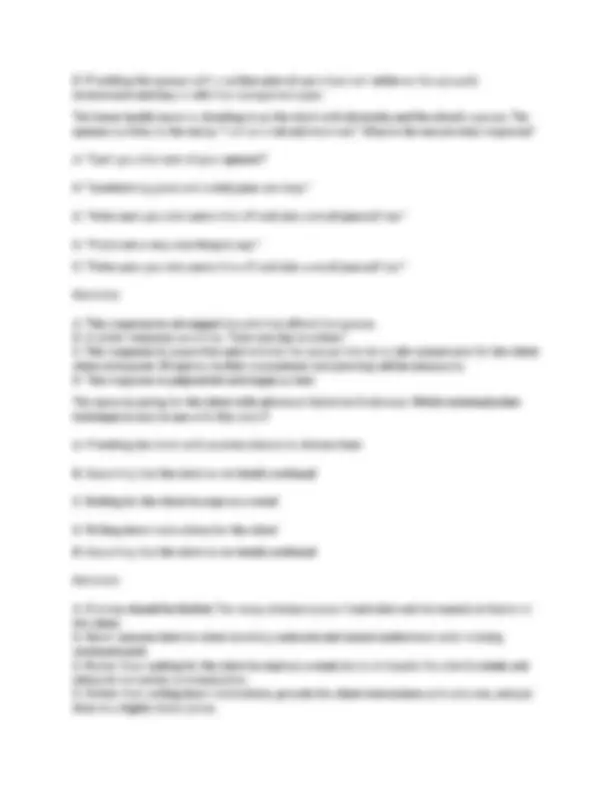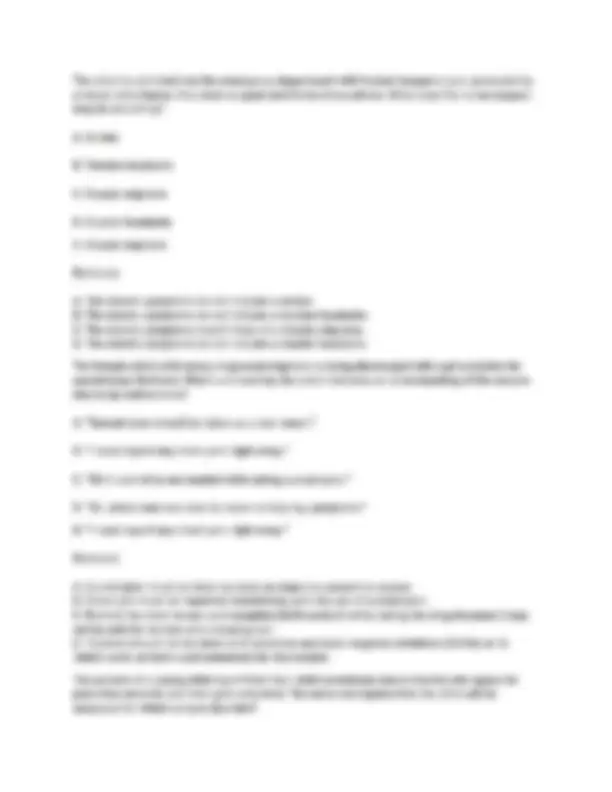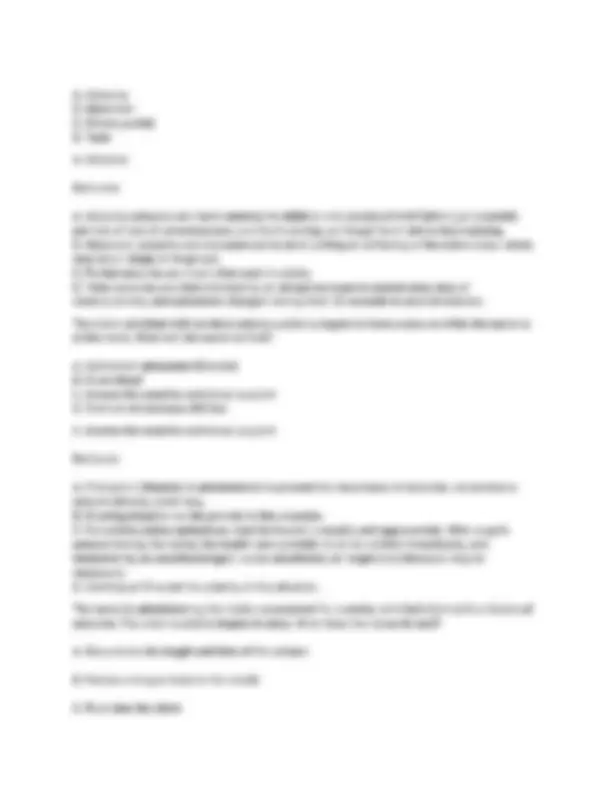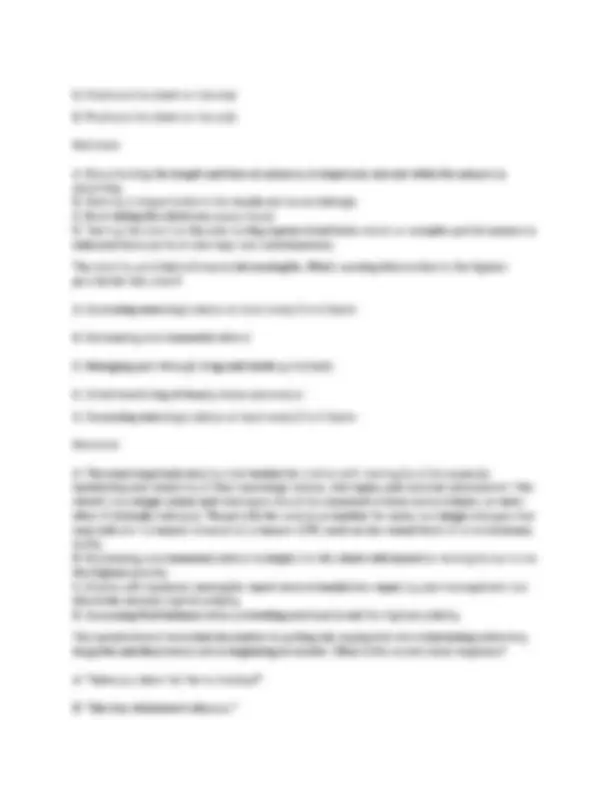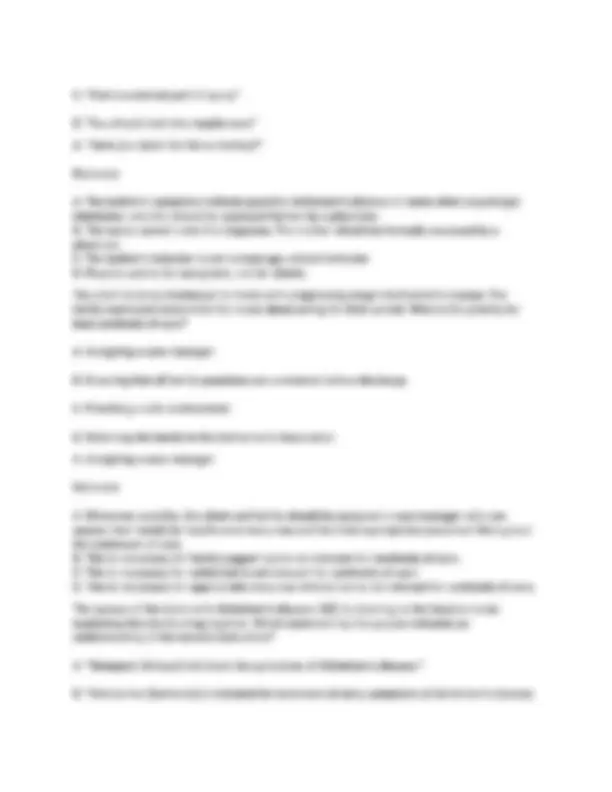Partial preview of the text
Download Medical Surgical Nursing Final Exam Test Banks 1300 Questions with Correct Answers. and more Exams Nursing in PDF only on Docsity!
Medical Surgical Nursing Final Exam Test Banks 1300 Questions with Correct Answers and Expert Verified Explanations 1, A nurse assesses a client with polycystic kidney disease (PKD). Which assessment finding should alert the nurse to immediately contact the health care provider? a. Flank pain b. Periorbital edema c. Bloody and cloudy urine d. Enlarged abdomen ANS: B Periorbital edema would not be a finding related to PAD and should be investigated further. Flank pain and a distended or enlarged abdomen occur in PKD because the kidneys enlarge and displace other organs. Urine can be bloody or cloudy as a result of cyst rupture or infection. 2. A nurse cares for a client with autosomal dominant polycystic kidney disease (ADPKD). The client asks, “Will my children develop this disease?" How should the nurse respond? a. "No genetic link is known, so your children are not at increased risk." b. "Your sons will develop this disease because it has a sex-linked gene." c. “Only if bath you and your spouse are carriers of this disease." d. “Each of your children has a 50% risk of having ADPKD." ANS: D Children whose parent has the autosomal dominant form of PKD have a 50% chance of inheriting the gene that causes the disease. ADPKD is transmitted as an autosomal dominant trait and therefore is not gender specific. Both parents do not need to have this disorder. 3. After teaching a client with early polycystic kidney disease (PKD) about nutritional therapy, the nurse assesses the client's understanding. Which statement made by the client indicates a correct understanding of the teaching? a. "| will take a laxative every night before going to bed." b. “| must increase my intake of dietary fiber and fluids." ¢. "Il shall only use salt when | am cooking my own food," d. "I'll eat white bread to minimize gastrointestinal gas.” ANS: B Clients with PKO often have constipation, which can be managed with increased fiber, exercise, and drinking plenty of water. Laxatives should be used cautiously. Clients with PKD should be on a restricted salt diet, which includes not cooking with salt. White bread has a low fiber count and would not be included in a high-fiber diet. 4, A nurse cares for a middle-aged female client with diabetes mellitus who is being treated for the third episode of acute pyelonephritis in the past year. The client asks, "What can | do to help prevent these infections?" How should the nurse respond? a, "Test your urine daily for the presence of ketone bodies and proteins.” b. “Use tampons rather than sanitary napkins during your menstrual period.” c. “Drink more water and empty your bladder more frequently during the day.” d. "Keep your hemoglobin Alc under 9% by keeping your blood sugar controlled." ANS: C Clients with long-standing diabetes mellitus are at risk for pyelonephritis for many reasons. Chronically elevated blood glucose levels spill glucose into the urine, changing the pH and providing a favorable climate for bacterial growth, The neuropathy associated with diabetes reduces bladder tone and reduces the client's sensation of bladder fullness. Thus, even with large amounts of urine, the client voids less frequently, allowing stasis and overgrowth of microorganisms. Increasing fluid intake (specifically water) and voiding frequently prevent stasis and bacterial overgrowth. Testing urine and using tampons will not help prevent pyelonephritis. A hemogiabin Alc of 9% is too high. 5. A nurse evaluates a client with acute glomerulonephritis (GN). Which manifestation should the nurse recognize as a positive response to the prescribed treatment? a, The client has last 11 pounds in the past 10 days. b. The client's urine specific gravity is 1.048. ¢. No blood is observed in the client's urine. d. The client's blood pressure is 152/88 mm Hg. ANS: A Fluid retention is a major feature of acute GN. This weight loss represents fluid loss, indicating that the glomeruli are performing the function of filtration. A urine specific gravity of 1.048 is high. Blood is not usually seen in GN, so this finding would be expected. A blood pressure of 152/88 mm Hg is too high; this may indicate kidney damage or fluid overload. 6. After teaching a client with nephrotic syndrome and a normal glomerular filtration, the nurse assesses the client's understanding. Which statement made by the client indicates a correct understanding of the nutritional therapy for this condition? a. “| must decrease my intake of fat." b. “I will increase my intake of protein.” c. “A decreased intake of carbohydrates will be required.” d. “An increased intake of vitamin C is necessary.” ANS: B In nephrotic syndrome, the renal loss of protein is significant, leading to hypoalbuminemia and edema formation. If glomerular filtration is normal or near normal, increased protein loss should be matched by increased intake of protein. The client would not need to adjust fat, carbohydrates, or vitamins based on this disorder. consuming fluids earlier in the day. Blood pressure control is needed to slow the progression of renal dysfunction. When dietary protein is restricted, refer the client to the registered dietitian as needed. 10. A nurse cares for a client who is recovering after a nephrostomy tube was placed 6 hours ago. The nurse notes drainage in the tube has decreased from 40 mL/hr to 12 mL over the last hour. Which action should the nurse take? a. Document the finding in the client's record. b. Evaluate the tube as working in the hand-off report. ¢. Clamp the tube in preparation for removing it. d. Assess the client's abdomen and vital signs. ANS: D The nephrostomy tube should continue to have a consistent amount of drainage. If the drainage slows or stops, it may be obstructed, The nurse must nolify the provider, but first should carefully assess the client's abdomen for pain and distention and check vital signs so that this information can be reported as well The other interventions are not appropriate. 1. A nurse teaches a client who is recovering from a nephrectomy secondary to kidney trauma. Which statement should the nurse include in this client's teaching? a, "Since you only have one kidney, a salt and fluid restriction is required.” b. "Your therapy will include hemodialysis while you recover.” c. “Medication will be prescribed to control your high blood pressure.” d. "You need to avoid participating in contact sports like football.” ANS: D Clients with one kidney need to avoid contact sports because the kidneys are easily injured. The client will not be required to restrict salt and fluids, end up on dialysis, or have new hypertension because of the nephrectomy. 12. 4 nurse provides health screening for a community health center with a large population of African-American clients. Which priority assessment should the nurse include when working with this population? a. Measure height and weight. b. Assess blood pressure. c. Observe for any signs of abuse. d. Ask about medications. ANS: B All interventions are important for the visiting nurse to accomplish, However, African Americans have a high rate of hypertension leading to end-stage renal disease. Each encounter that the nurse has with an African-American client provides a chance to detect hypertension and treat it. If the client is already on antihypertensive medication, assessing blood pressure monitors therapy. 13. After teaching a client with renal cancer who is prescribed temsirolimus (Torisel), the nurse assesses the client's understanding. Which statement made by the client indicates a correct understanding of the teaching? a. "I will take this medication with food and plenty of water." b. “I shall keep my appointment at the infusion center each week.” c. “UL limit my intake of green leafy vegetables while on this medication." d. “| must not take this medication if | have an infection or am feeling ill.” ANS: B Temsirolimus is administered as.a weekly intravenous infusion. This medication blocks protein that is needed for cell division and therefore inhibits cell cycle progression. This medication Is not taken orally, and clients do not need to follow a specific diet. 14, A nurse cares for a client who has pyelonephritis, The client states, “| am embarrassed to talk about my symptoms." How should the nurse respond? a. "| am a professional. Your symptoms will be kept in confidence." b. “| understand. Elimination is a private topic and shouldn't be discussed." ¢. “Take your time. It is okay to use words thal are familiar to you." d. "You seem anxious. Would you like a nurse of the same gender to care for you?" ANS: C Clients may be uncomfortable discussing issues related to elimination and the genitourinary area. The nurse should encourage the client to use language that is familiar to the client. The nurse should nat make promises that cannot be kept, like keeping the client's symptoms confidential. The nurse must assess the client and cannot take the time to stop the discussion or find another nurse ta complete the assessment. 1A nurse assesses a client who has a family history of polycystic kidney disease (PKD). For which clinical manifestations should the nurse assess? (Select all that apply.) a, Nocturia b. Flank pain c. Increased abdominal girth d. Dysuria e. Hematuria f. Diarrhea ANS: B, C,E Clients with PKD experience abdominal distention that manifests as flank pain and increased abdominal girth. Bloody urine is also present with tissue damage secondary to PKD. Clients with PKD often experience constipation, but would not report nocturia or dysuria. 2. A nurse assesses a client with nephrotic syndrome. For which clinical manifestations should the nurse assess? (Select all that apply.) a. Proteinuria b, Hypoalbuminemia ¢. Dehydration @. Lipiduria e. Dysuria {. Costovertebral angle (CVA) tenderness limit salt intake, and adjust dietary selections to prevent constipation. The client should natify the provider if urine smells foul or has blood in it, as these are signs of a urinary tract infection or glomerular injury. The client should atso notity the provider if visual disturbances are experienced, as this is a sign of a possible berry aneurysm, which is a complication of PKD. Diarrhea and renal stones are not manifestations or complications of PKD; therefore, teaching related to these concepts would be inappropriate. 1. An emergency department nurse cares for a client who is severely dehydrated and is prescribed 3 L of intravenous fluid over 6 hours. At what rate (mL/br) should the nurse set the intravenous pump to infuse the fluids? (Record your answer using a whole number.) __ mL/hr ANS: 500 mL/br Because IV pumps deliver in units of milliliters per hour, the pump would have to be set at 500 mL/hr to deliver 3 L (3000 mL) over 6 hours. éx= 3000 x= 500 When caring for a client with polycystic kidney disease, which goal is most impartant? Preventing progression of the disease Performing genetic testing Assessing for related causes Consulting with the dialysis unit Preventing progression of the disease Correct Preventing complications and progression of the disease is the goal. Genetic testing should be done, but this is not a priority. Assessment for related causes is an intervention, not a goal. Not all clients with polycystic kidney disease require dialysis. The nurse receives reportona client with hydronephrosis. Which laboratory study does the nurse monitor? Hemoglobin and hematocrit (H&H) White blood cell (WBC) count Blood urea nitrogen (BUN) and creatinine Lipid levels Blood urea nitrogen (BUN) and creatinine BUN and creatinine are kidney function tests. With back-pressure on the kidney, glomerular filtration is reduced or absent, resulting in permanent kidney damage. Hydronephrosis results fram the backup of urine secondary to obstruction; H&H monitors for anemia and blood loss, while WBC count indicates infection. Elevated lipid levels are associated with nephrotic syndrome, not with obstruction and hydronephrosis. When preparing a client for nephrostomy tube insertion, it is essential for the nurse to monitor which factor before the procedure? Blood urea nitrogen (BUN) and creatinine Hemoglobin and hematocrit (HEH) Intake and output (/&0) Prothrombin time (PT) and international normalized ratio (INR) Prothrombin time (PT) and international normalized ratio (INR) The procedure will be cancelled or delayed if coagulopathy in the form of prolonged PT/INR exists because dangerous bleeding may result, Nephrostomy tubes are placed to prevent and treat kidney damage; monitoring BUN and creatinine is important, but is not essential before this procedure. HGH is monitored to detect anemia and blood loss; this would not occur before the procedure. This client should be on 1&0 during the entire hospitalization; it is not necessary only before the procedure, but throughout the admission. Which condition may predispose a client to chronic pyelonephritis? Spinal cord injury Cardiomyopathy Hepatic failure Glomerulonephritis Spinal cord injury Chronic pyelonephritis occurs with spinal cord injury, bladder tumor, prostate enlargement, or urinary tract stones. Weakness of the heart muscle may cause kidney impairment, not an infection. Pyelonephritis may damage the kidney, nat the liver. Glomerulonephritis may result from infection, but may not cause infection of the kidney. When assessing a client with acute glomerulonephritis, which finding causes the nurse to notify the provider? Purulent wound on the leg Crackles throughout the lung fields History of diabetes Cola-colored urine Crackles throughout the lung fields Crackles indicate fluid overioad resulting from kidney damage; shortness of breath and dyspnea are typically associated. The provider should be notified of this finding. Glomerulonephritis may result from infection (e.g., purulent wound); it is not an emergency about which to notify the provider. The history of diabetes would have been obtained on admission. Dark urine is expected in glomerulonephritis. When caring for a client who had a nephrostomy tube inserted 4 hours ago, which is essential for the nurse to report to the health care provider? Dark pink-colored urine Small amount of urine leaking around the catheter Tube that has stopped draining Creatinine of 1.8 mg/dL Tube that has stopped draining The provider must be notified when a nephrostomy tube does not drain; it could be obstructed or dislodged, Pink or red drainage is expected for 12 to 24 hours after insertion and should Elevation in blood urea nitrogen (BUN) Oliguria Microalbuminuria Painless hematuria Microalbuminuria In the early stages of diabetic nephropathy, micro-levels of albumin are first detected in the urine. Progressive kidney damage occurs before dipstick procedures can detect protein in the urine. BUN may change in response to protein and fluid intake. Oliguria is a later finding in kidney disease and may also be present in dehydration. Painless hematuria often occurs with kidney cancer. Which statement by a client with diabetic nephropathy indicates a need for further education about the disease? "Diabetes is the leading cause of kidney failure.” "| need less insulin, so | am getting better.” “My blood sugar may drop really low at times.” “| must call my provider if the urine dipstick shows protein." “| need less insulin, so | am getting better.” When kidney function is reduced, insulin is available for a longer time and thus less of it is needed. Unfortunately, many clients believe this means that their diabetes is improving. It is true that diabetes mellitus is the leading cause of end-stage kidney disease among Caucasians in the United States, Clients with warsening kidney function may begin to have frequent hypoglycemic episodes. Proteinuria, which may be mild, moderate, or severe, indicates a need for follow-up. During discharge teaching for a client with kidney disease, what does the nurse teach the client to do? “Drink 2 liters of fluid and urinate at the same time every day.” “Eat breakfast and go to bed at the same time every day." "Check your blood sugar and do a urine dipstick test." “Weigh yourself and take your blood pressure." “Weigh yourself and take your blood pressure." Regular weight assessment monitors fluid restriction control, while blood pressure control is necessary to reduce cardiovascular complications and slow the progression of kidney dysfunction. Fluid intake and urination, and breakfast time and bedtime, do not need to be at the same time each day. Clients with diabetes, not kidney disease, should regularly check their blood sugar and perform a urine dipstick test. The school nurse is counseling a teenage student about how to prevent kidney trauma. Which statement by the student indicates a need for further teaching? “I can't play any type of contact sports because my brother had kidney cancer.” "| avoid riding motorcycles.” “Lalways wear pads when playing football.“ "lL always wear a seat belt in the car." "I can't play any type of contact sports because my brother had kidney cancer." Contact sports and high-risk activities should be avoided if a person has only one kidney. A family history of kidney cancer does not prohibit this type of activity. To prevent kidney and genitourinary trauma, caution should be taken when riding bicycles and motorcycles. People should wear appropriate protective clothing when participating in contact sports. Anyone riding in a car should wear a seat belt. A client is hesitant to talk to the nurse about genitourinary dysfunction symptoms. Whal is the nurse's best response? “Don't worry, no one else will know." “Take your time. What is bothering you the most?" “Why are you hesitant?” “You need to tell me so we can determine what is wrong.” "Take your time. What is bothering you the most?" Asking the client what is bothering him or her expresses patience and understanding when trying to identify the client's problem. Telling the client that others will not know is untrue because the client's symptoms will be in the medical record for other health care personnel to see. Asking why the client is hesitant can seem accusatory and threatening to the client. Admonishing the client to disclose his or her symptoms is too demanding; the nurse must be more understanding of the client's embarrassment. The nurse is performing discharge teaching for a client after a nephrectomy for renal cell carcinoma. Which statement by the client indicates that teaching has been effective? “Because renal cell carcinoma usually affects both kidneys, I'll need to be watched closely.” “Ill eventually require some type of renal replacement therapy." “Til need to decrease my fluid intake to prevent stress to my remaining kidney." “My remaining kidney will provide me with normal kidney function now." “My remaining kidney will provide me with normal kidney function now." After a nephrectomy, the second kidney is expected to eventually provide adequate kidney function, but this may take days or weeks. Renal cell carcinoma typically only affects one kidney. Renal replacement therapy is not the typical treatment for renal cell carcinoma. Fluids should be maintained to flush the remaining kidney. A client, who isa mother of two, has autosomal dominant polycystic kidney disease (ADPKD). Which statement by the client indicates a need for further education about her disease? “By maintaining a low-salt diet in our house, | can prevent ADPKD in my children." “Even though my children don't have symptoms al the same age I did, they can still have ADPKD." “if my children have the ADPKD gene, they will have cysts by the age of 30." “My children have a 50% chance af inheriting the ADPKD gene that causes the disease.” "By maintaining a low-salt diet in our house, | can prevent ADPKD in my children.” There is no way to prevent ADPKD, although early detection and management of hypertension may slow the progression of kidney damage. Limiting salt intake can help control blood pressure. Presentation of ADPKD can vary by age of onset, manifestations, and illness severity, even in one family. Almost 100% of those who inherit a polycystic kidney disease Urinary antiseptic drugs such as nitrofurantoin (Macrodantin) are prescribed to provide comfort for clients with pyelonephritis. Antibiotics, not antiseptics, are used to decrease bacterial count and treat pyelonephritis infection; the action of antibiotics is not enhanced with antiseptics. White blood cells, along with antibiotics, fight infection. When caring for a client 24 hours after a nephrectomy, the nurse notes that the client's abdomen is distended, Which action does the nurse perform next? Check vital signs. Notify the surgeon. Continue to monitor. Insert a nasogastric (NG) tube. Check vital signs. The client's abdomen may be distended from bleeding; hemorrhage or adrenal insufficiency causes hypotension, so vital signs should be taken to see if a change in blood pressure has occurred. The surgeon should be notified after vital signs are assessed. An NG tube is not indicated for this client. After receiving change-of-shift report on the urology unit, which client does the nurse assess first? Client post radical nephrectomy whose temperature is 99.8° F (37.4° C) Client with glomerulonephritis who has cola-colored urine Client who was involved in a motor vehicle crash and has hematuria Client with nephrotic syndrome who has gained 2 kg since yesterday The nurse should be aware of the risk for kidney trauma after a motor vehicle crash; this client needs further assessment and evaluation to determine the extent of blood loss and the reason for the hematuria because hemorrhage can be life-threatening. Although slightly elevated, the low-grade fever of the client who is post radical nephrectomy is not life-threatening in the same way as a trauma victim with bleeding. Cola-colared urine is an expected finding in glomerulonephritis. Because of loss of albumin, fluid shifts and weight gain can be anticipated ina client with nephrotic syndrome. A newly admitted client who is diabetic and has pyelonephritis and prescriptions for intravenous antibiotics, blood glucose monitoring every 2 hours, and insulin administration should be cared for by which staff member? RN whose other assignments include a client receiving chemotherapy for renal cell carcinoma RN who is caring for a client who just returned after having renal artery balloon angioplasty RN who has just completed preoperative teaching for a client who is scheduled for nephrectomy RN who is currently admitting a client with acute hypertension and possible renal artery stenosis The client scheduled for nephrectomy is the most stable client; the RN caring for this client will have time to perform the frequent monitoring and interventions that are needed for the newly admitted client. The client receiving chemotherapy will require frequent monitoring by the RN. The client after angioplasty will require frequent vital sign assessment and observation for hemorrhage and arterial occlusion. The client with acute hypertension will need frequent monitoring and medication administration. The nurse anticipates that a client who develops hypotension and oliguria post nephrectomy may need the addition of which element to the regimen? Increase in analgesics Addition of a corticosteroid Administration of a diuretic Course of antibiotic therapy Loss of water and sodium occurs in clients with adrenal insufficiency, which is followed by hypotension and oliguria; corticosteroids may be needed. The nurse should use caution when administering analgesics to a hypotensive client; no indication suggests that pain is present in this client. A diuretic would further contribute to fluid loss and hypotension, potentially worsening kidney function. A few doses of antibiotics are used prophylactically preoperatively and postoperatively; additional therapy is used when evidence of infection exists. When caring for a client with hemorrhage secondary to kidney trauma, the nurse provides volume expansion. Which element does the nurse anticipate will be used? Fresh-frozen plasma Platelet infusions 5% dextrose in water Normal saline solution (NSS) Isotonic solutions and crystalloid solutions are administered for volume expansion; 0.9% sodium chloride (NSS) and 5% dextrose in 0.45% sodium chloride may be used. Clotting factors, contained in fresh-frozen plasma, are given for bleeding, not for valume expansion, Platelet infusions are administered for deficiency of platelets. A solution hypotonic to the client's blood, 5% dextrose, is administered for nutrition or hypernatremia, not for volume expansion. The nurse is caring for a client who has just returned to the surgical unit after a radical nephrectomy. Which assessment information alarms the nurse? Blood pressure is 98/56 mm Hg; heart rate is 118 beats/min. Urine output over the past hour was 80 mL Pain is at a level 4 (on a 0-to-10 scale). Dressing has a 1-crm area of bleeding. Bleeding is a complication of radical nephrectomy: tachycardia and hypotension may indicate impending hypovolemic or hemorrhagic shock. The surgeon should be notified immediately and fluids should be administered, complete blood count should be checked, and blood administered, if necessary, A urine output of 80 mL can be considered normal, The nurse can administer pain medication, but must address hemodynamic instability and possible hemorrhage first. Administering pain medication to a client who has developed shock will exacerbate hypotension. A dressing with a l-cm area of bleeding is expected postoperatively, The RN is working with unlicensed assistive personnel (UAP) in caring for a group of clients. Which action is best for the RN ta delegate to UAP? typically have catheters inserted, so the LPN/LVN from the kidney dialysis unit would not be the best staff member to assign to the client. The nurse who has been out of practice for several years is not the best candidate to insert a catheter in a client with an enlarged prostate. Which assessment findings does the nurse expect in a client with kidney cancer? (Select all that apply.) Erythracytasis Hypokalemia Hypercalcemia Hepatic dysfunction Increased sedimentation rate Erythracytasis Correct Hypokalemia Hypercalcemia Correct Hepatic dysfunction Correct Increased sedimentation rate Correct Erythrocytosis alternating with anemia and hepatic dysfunction with elevated liver enzymes may occur with kidney cancer. Parathyroid hormone produced by tumor cells can cause hypercalcemia, An elevation in sedimentation rate may occur in paraneoplastic syndromes. Potassium levels are not altered in kidney cancer, but hypercalcemia is present. When assessing a client with acute pyelonephritis, which findings does the nurse anticipate will be present? (Select all that apply.) Suprapubic pain Vomiting Chills Dysuria Oliguria Suprapubic pain Vomiting Correct Chills Correct Dysuria Correct Oliguria Nausea and vomiting are symptoms of acute pyelonephritis. Chills along with fever may also occur, as well as burning (dysuria), urgency, and frequency. Suprapubic pain is indicative of cystitis, not kidney infection (pyelonephritis). Oliguria is related to kidney impairment from severe or long-standing pyelonephritis. 1. A nurse assesses clients on the medical-surgical unit. Which client is at greatest risk for the development of bacterial cystitis? a. A 34-year-old female who has never been pregnant b, A 42-year-old male who is prescribed cyclophosphamide c. A 58-year-old female who is not taking estrogen replacement d. A 77-year-old male with mild congestive heart failure ANS: C Females at any age are more susceptible to cystitis than men because of the shorter urethra in women. Postmenopausal women who are not on hormone replacement therapy are at increased risk for bacterial cystitis because of changes in the cells of the urethra and vagina. The middle-aged woman who has never been pregnant would not have a risk potential as high as the older woman who is nat using hormone replacement therapy. DIF: Understanding/Comprehension REF- 1344 KEY: Cystitis] health screening MSC: Integrated Process: Nursing Process: Assessment NOT: Client Needs Category: Safe and Effective Care Environment: Management of Care 2. A nurse reviews the laboratory findings of a client with a urinary tract infection. The laboratory report notes a shift to the left in a clients white blood cell count. Which action should the nurse take? a, Request that the laboratory perform a differential analysis on the white blood cells, b. Notify the provider and start an intravenous line for parenteral antibiotics. c¢. Collaborate with the unlicensed assistive personnel (UAP) to strain the clients urine for renal calculi. d. Assess the client for a potential allergic reaction and anaphylactic shock. ANS: B An increase in band cells creates a shift to the left. A left shift most commonly occurs with urosepsis and is seen rarely with uncomplicated urinary tract infections. The nurse will be administering antibiotics, most likely via IV, so he or she should notify the provider and prepare to give the antibiotics. The shift to the left is part of a differential white blood cell count. The nurse would not need to strain urine for stones. Allergic reactions are associated with elevated eosinophil cells, not band cells. DIF: Applying/Application REF: 1347 KEY: Cystitis] assessment/diagnostic examination MSC: Integrated Process: Nursing Process: Implementation NOT: Client Needs Category: Physiolagical Integrity: Physiological Adaptation 3. A nurse cares for a postmenopausal client who has had two episodes of bacterial urethritis in the last 6 months. The client asks, | never have urinary tract infections. Why is this happening now? How should the nurse respond? ¢. | must avoid drinking caffeinated beverages. d. | shall try to lose about 10% of my body weight. ANS: A Limiting fluids concentrates urine and can irritate tissues, leading to increased incontinence. Many people try to manage incontinence by limiting fluids. Alcoholic and caffeinated beverages are bladder stimulants. Obesity increases intra-abdominal pressure, causing incontinence. DIF: Applying/Application REF: 1357 KEY: Cystitis] hydration MSC: Integrated Process: Teaching/Learning NOT; Client Needs Category: Physiological Integrity; Basic Care and Camfort 6. A nurse cares for adult clients who experience urge incontinence. For which client should the nurse plan a habit training program? a. A 78-year-old female who is confused b. A 65-year-old mate with diabetes mellitus c. A §2-year-old female with kidney failure d. A 47-year-old male with arthritis ANS: A For a bladder training program to succeed in a client with urge incontinence, the client must be alert, aware, and able to resist the urge to urinate. Habit training will work best for a confused client. This includes going to the bathroom (or being assisted to the bathroom) at set times. The other clients may benefit from another type of bladder training, DIF: Applying/Application REF: 1357 KEY: Urinary incontinence] health screening MSC: Integrated Process: Nursing Process: Assessment NOT: Client Needs Category: Physiological Integrity: Physiological Adaptation 7. After delegating care to an unlicensed assistive personnel (UAP) for a client who is prescribed habit training to manage incontinence, a nurse evaluates the UAPs understanding, Which action indicates the UAP needs additional teaching? @. Toileting the client after breakfast b, Changing the clients incontinence brief when wet c. Encouraging the client to drink fluids d, Recording the clients incontinence episodes ANS: B Habit training is undermined by the use of absorbent incontinence briefs or pads. The nurse should re-educate the UAP on the technique of habit training. The UAP should continue to toilet the client after meals, encourage the client to drink fluids, and record incontinent episodes. DIF: Applying/Application REF: 1358 KEY: Urinary incontinence| delegation| supervision] unticensed assistive personnel (UAP) MSC: Integrated Process: Teaching/Learning NOT: Client Needs Category: Safe and Effective Care Enviranment: Management of Care 8. Anurse plans care for a client with overflow incontinence. Which intervention should the nurse include in this clients plan of care to assist with elimination? a. Stroke the medial aspect of the thigh. b. Use intermittent catheterization. c. Provide digital anal stimulation. d. Use the Valsalva maneuver. ANS: D In clients with overflow incontinence, the veiding reflex arc is not intact. Mechanical pressure, such as that achieved through the Valsalva maneuver (holding the breath and bearing down as if to defecate), can initiate voiding. Stroking the medial aspect of the thigh or providing digital anal stimulation requires the reflex arc to be Intact to initiate elimination. Due to the high risk for infection, intermittent catheterization should only be implemented when other interventions are not successful. DIF: Applying/Apptication REF: 1358: KEY: Urinary incontinence MSC: Integrated Process: Nursing Process: Implementation NOT: Client Needs Category: Physiological Integrity: Basic Care and Comfort 9. A confused client with pneumonia is admitted with an indwelling catheter in place. During interdisciplinary rounds the following day, which question should the nurse ask the primary health care provider? a. Do you want daily weights on this client? b. Will the client be able to return home? c. Can we discontinue the indwelling catheter? d. Should we get another chest x-ray today? ANS: C An indwelling catheter dramatically increases the risks of urinary tract infection and urosepsis. Nursing staff should ensure that catheters are left in place only as long as they are medically needed. The nurse should inquire about removing the catheter. All other questions might be appropriate, but because of client safety, this 
